Australian
and international
exploratory
performance and
media arts
Vinyl 7”, Independent Press, IP02
www.iebrisbane.com.au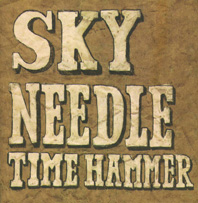
Sky Needle, Time Hammer
Fortuitously, Sky Needle’s 7″ vinyl disc Time Hammer arrived on my doorstep just after I was given a turntable (having been bereft of one for the last decade). While the group Sky Needle was not known to me (named after the Brisbane architectural folly built for Expo 88 and then purchased by millionaire hairdresser Stefan), two of its three members, Joel Stern and Ross Manning, are Brisbane experimental music stalwarts and they have found a kindred spirit in visual/sound artist Alex Cuffe.
Each plays a curious home made instrument—Stern on “latex pump horn,” Manning on “elastic dust shovel,” and Cuffe on “speaker box.” The result is a joyous, wonky kind of sound, curiously reminiscent of 80s post-punk, crafted into two reasonably tight tracks that are not so much funky as kind of…thunky.
This is a music in which the raw materials of the instruments (including elastic bands, a kitchen dust pan, old speaker housing and lengths of garden hose) are allowed to shine, introducing alternate harmonics and tasty timbres. The plunky twang of Manning’s dust shovel wraps around the chewy rubberiness of Cuffe’s speaker box, punctuated by the nasal honks of Stern’s footpump operated horns (a much more pleasing tonality than a stadium full of vuvuzelas).
Side A offers “Sweet 16 Snorks” which starts with driving buzzy bass notes that play in and around the higher string line, offset by staccato horn hoots and clanging pulses. This weighty intro quickly shifts into a higher, looser and lyrical interplay of strings and horn swoops, only to shift again into a third section of more agitated rhythms, handclaps and jangles. There is a real agility to the structural shifts in this piece, evincing the experience of the artists.
Side B gives us “The Stain” which offers a looser approach with minimalist rhythm figures, occasionally hinting at dissolution, which unevenly accumulate until an abrupt halt. I wish Time Hammer had been a 10-inch single so I could really see where “The Stain” might go.
Almost danceable and strangely cute, Sky Needle’s Time Hammer makes a fine start to my contemporary vinyl collection.
Gail Priest
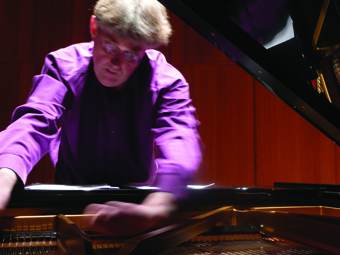
Roger Dean
photo Philippa Horn
Roger Dean
late night sonics
In the first of two collaborations with the vocal ensemble Halcyon, austraLYSIS presents Late Night Sonic Space in Sydney, July 31. Formed in 1970 and working with interactive and network technology since 1995, austraLYSIS has developed a number of innovative methods for controlling rhythmic, timbral and harmonic interaction. The program includes two purely electroacoustic works, one of them by Canadian composer Robert Normandeau; the premiere of Toy Language 1, composed by Roger Dean for mezzo soprano and Halcyon co-founder Jenny Duck-Chong, with live electronics; and a sound and text work called Clay Conversations 2, by Hazel Smith and Joanna Still (UK). There will also be the opportunity to converse with the creators themselves about their work after the concert. The program is presented by the New Music Network with the support of ABC Classic FM and takes place at the ABC Centre, Ultimo. austraLYSIS and halcyon, Late Night Sonic Space, Studio 227, ABC Centre, Ultimo, Sydney, July 31 10.30pm; www.newmusicnetwork.com.au
brodsky quartet, eddie perfect & topology
For some reason the Brodsky Quartet (UK) has surprisingly chosen to escape the northern summer for our winter. The quartet is playing a variety of concerts, though one of the most intriguing is the Songs from the Middle series of performances with Eddie Perfect and musicians from the Australian National Academy of Music (ANAM). Apparently it involves Eddie returning to his roots, and more specifically to the Melbourne suburb of Mentone, where entertainment includes the beach, the bowling club and, more recently, Bunnings. This bout of nostalgia has apparently been brought on by the arrival of a baby girl so perhaps the show will be a new father’s postmodern paean to working families moving forward. You can also see the Brodsky Quartet in concert with contemproary classical ensemble Topology, as part of the Brisbane Powerhouse’s OMG (Other Musical Genres) series. Topology have previously been described by Keith Gallasch as “a live working band with a casually theatrical and jazzy spontaneity.” (You can hear a sample of their work in RealTime’s first sound capsule here.) The Brodsky Quartet, Australian tour, July 22-Aug 8; The Brodsky Quartet, Eddie Perfect, and ANAM musicians, ANAM, Melbourne, July 25-26, Sydney Opera House, Aug 1, Brisbane Powerhouse Aug 6; The Brodsky Quartet and Topology, Brisbane Powerhouse, Aug 8.
sizzling new music at the bowling club
More music news…Ensemble Offspring first conceived of Sizzle as an alternative musical event for Sydney in winter, and better yet as a way of getting contemporary classical music out of the concert hall and into people’s Sunday afternoons. So each Ensemble Offspring member, Bree van Reyk, Veronique Serret and Jason Noble, is curating a musical event at his or her local bowling club (maybe Eddie could come). Noble started proceedings last month in Waverley, and van Reyk continued things this month in Petersham. For the final instalment next month Veronique Serret has invited The Noise improv string quartet, spoken word artist Eleanor Knox, CODA, visual artists and, of course, Ensemble Offspring, to play at the Camperdown Bowling Club. Ensemble Offspring and others, Camperdown Bowling Club, Mallett Street, Camperdown, Sydney, August 1
everyday crisis management
The phrase ‘human interest story’ brings to mind images of personal stories at the end of news broadcasts: babies, animals and, if you’re really lucky, baby animals—in short, everything you’re supposed to avoid in show business. That said, it’s also a catchy title, especially for a show that promises to investigate the relationship between the medium, the message and the mobilisation of empathy. Lucy Guerin’s latest show, commissioned by Malthouse Theatre and the Perth International Arts Festival, “explores our shared consumption of media news” and the “personal impact of the global crises delivered daily to our doorsteps” (press release). Like much of Guerin’s work, surveyed in RealTime’s Archive Highlights here, Human Interest Story combines imagery, gesture and sound to almost surreal effect. Created by an outstanding ensemble of dancers and collaborators and featuring design by Gideon Obarzanek (Mortal Engine), lighting by Paul Jackson and a very special newscast by Anton Enus (SBS), Human Interest Story premieres in Melbourne before touring to Perth. Lucy Guerin Inc, Human Interest Story, Malthouse Theatre, July 23-August 1; www.malthousetheatre.com.au; Perth International Arts Festival Feb 11-March 7 2011
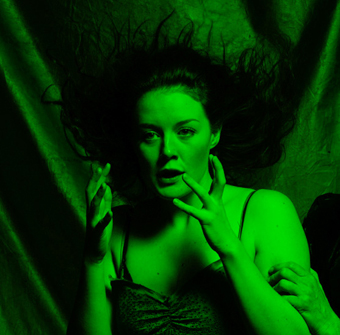
Jenny Kemp, Madeleine
photo courtesy of Malthouse
Jenny Kemp, Madeleine
contemplating madness
One issue that has often made the news over the past year is mental health, first when Professor Pat McGorry was appointed as Australian of the Year and then when Professor John Mendoza resigned from the National Advisory Council on Mental Health in frustration at the government’s efforts or lack thereof. Of course, themes of mental health and illness have a long history in art and theatre. One example is Jenny Kemp’s exploration of loss, longing and mania in her 2008 work Kitten. This month, this adventurous writer-director of dream like performance works mounts the companion piece, Madeleine, at Arts House, Melbourne. Madeleine is turning 19 and starting to show signs of schizophrenia. As she disintegrates mentally so too does her family, and together they are thrust onto the path to tragedy. Madeleine “brings the uncertain world of mental illness into presence, for contemplation. It provides a space within which these concerns can become a reality—a poetic reality of beauty, humour and horror” (press release). Jenny Kemp and Black Sequin Productions, Madeleine, Arts House, North Melbourne August 3-8 https://www.melbourne.vic.gov.au/ArtsHouse/
computer gaming on in launceston
If you missed Game On, the exhibition devoted to the history of video games curated by the Barbican and hosted in Australia by ACMI in 2008 (RT84, p.29), then you might want to catch Game On 2.0. This new exhibition is having its world premiere at the Queen Victoria Museum and Art Gallery in Launceston. While the new version includes several new pinball machines and arcade games from the past, it also shows off the Virtusphere, which is apparently “the best locomotion interface for virtual entertainment.” Game On 2.0, Queen Victoria Museum and Art Gallery, Launceston, July 3-Oct 3, http://www.qvmag.tas.gov.au/gameon/
live-in performance art
Anastasia Klose has been sitting in bed since July 9 and will continue to do so until August 8. If you want to see her, she is at the Australian Experimental Art Foundation, Adelaide. But she’s not just sitting, she’s also writing, typing her thoughts onto her laptop. These musings, which shift from the banal to beautiful and back again (“Staring…Checking phone,” “you must never admit to your mistakes, you must instead claim them, as if you intended them,” “The anxiety of a white screen. Here is my new performance. Sit for 5 minutes without typing. Starting now. 3.04”) are then projected onto the white wall behind her that also serves as a bed head. The performance, titled i thought i was wrong but it turns out I was wrong, is accompanied by an essay called In bed with Anastasia: intimate strangers, written by Larissa Hjorth. Anastasia Klose, i thought i was wrong but it turns out I was wrong , Australian Experimental Art Foundation, July 9-Aug 8 http://aeaf.org.au/exhibitions/10_klose.html
RealTime issue #97 June-July 2010 pg. web
© RealTime ; for permission to reproduce apply to realtime@realtimearts.net
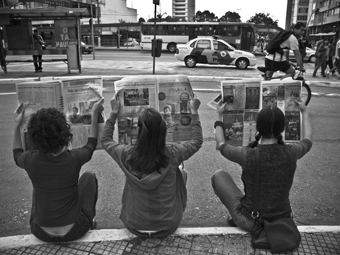
Out of Key(s), Opovoempé
photo courtesy of Opovoempé
Out of Key(s), Opovoempé
IN REALTIME 95 (“PERFORMANCE IN BRAZIL’S MEGA-METROPOLIS,” P42-43), CARLOS GOMES, A BRAZILIAN DIRECTOR BASED IN SYDNEY AND WORKING WITH THEATRE KANTANKA, REPORTED ON A RECENT VISIT TO SÃO PAULO, SURVEYING THE WAYS IN WHICH COMPANIES ARE ENGAGING WITH THEIR CITY, THEATRICALLY, POLITICALLY AND IN TERMS OF URBAN GEOGRAPHY. MELBOURNE ACTOR AND THEATRE MAKER JAMES BRENNAN RECENTLY VISITED THE CITY WHILE ON A KEITH AND ELISABETH MURDOCH TRAVELLING FELLOWSHIP. HE REPORTS HERE ON THE WORK OF THREE COMPANIES WHO CREATE WORKS IN WHICH THEY OCCUPY PUBLIC SPACE.
Whatever the country, theatre gives itself the mandate to claim space and to unravel that space in order to establish a relationship with those whom it seeks to make its public. I recently encountered three theatre companies in São Paulo, Brazil. What follows is an account of how each tackled public space, the audiences they found themselves ensconced with and the boundaries that marked their performances.
Compania Livre’s recent work was an adaptation of Dostoyevsky’s The Idiot, performed over three nights in SESC Pompeia, one of many SESC cultural sites found throughout São Paulo state (Serviço Social de Comércio is a non-government cultural network established in 1946 by the industrial sector). The site has a theatre space, but instead director Cibele Forjaz chose a large empty studio, adjacent to the theatre which has changed little since its past life as a steel drum factory. As one of Brazil’s most successful contemporary theatre directors, Forjaz has always had an appetite for unusual spaces. With her reputation she has access to a wide range of theatre venues in São Paulo, but continues to search out unconventional sites in which to house her visions.
In discussing The Idiot she said, “We wanted a space that held scene and public in connection…moreover, we required that as the spectacle developed, action could occur concurrently in several spaces.” This was achieved through a design which supported a number of overlapping performance areas, able to transform quickly, in keeping with, as Forjaz puts it, “the subjectivity of each character.” The success of Compania Livre’s well-integrated performance environment can also be attributed to the actors themselves. Accompanied by a musician and a small technical crew, they ran, sang, hovered, danced, washed and prayed the space into ever-new formations. When the work required the actors to articulate somewhat stylised moments, this was achieved with a sense of ease, as if an extension of their social selves rather than heightened performance personas. Furthermore when invited, the audience participated comfortably, contributing to an atmosphere of permission. In a characteristically Brazilian moment, audience joined actors as they sang a well-loved bossa nova song during the moving climax. Tears rolled on and off stage and in that moment I was a firm believer in “freedom inspires freedom.”
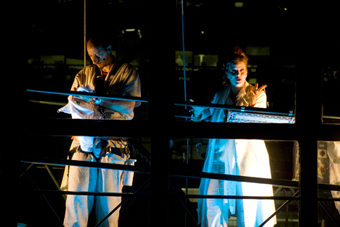
Kastelo, Teatro da Vertigem
photo Angelo Lorenzetti
Kastelo, Teatro da Vertigem
Another company which chose to forego the conventional performance space offered at another SESC site is Teatro da Vertigem (RT95, p42). This time, the design and overall effect served to distance audience and performer. Given that the work was an adaptation of Kafka’s The Castle, Kastelo, this did not seem inappropriate, since the work is marked by an inherent sense of distance. Kastelo was exactly the sort of work I was hoping to see in São Paulo—risky site-specific.
Performed on the outside of the SESC building by actors on moving window-cleaning platforms, the work was viewed by an audience seated on swivel chairs scattered throughout a disused office space on the fourth level of the building. The obvious risks of performing while suspended on cables were further emphasised by the actors, who, with an uncanny absence of apprehension, would jump off their platforms and hang from their harnesses. As the work developed, there was an increasing amount of head banging against the glass, sometimes done by swinging from a distance, which resulted in one of the actors dangling, upside down and bloody for long periods. Eliciting moments of empathy, ultimately Teatro da Vertigem was unable to bridge the gap between audience and actors. Like the protagonist, we also struggled to achieve meaningful contact.
Hand in hand with its commitment to exploring alternative arenas in which to perform, Teatro da Vertigem’s work has a strong social aspect. The company’s director, Antonio Araujo, listed projects which have engaged with locations in cities and rural areas and inside and outside various institutions. Recently the company commenced work on a project in Cracolandia (“Crack Land”), an area avoided by many São Paulo residents due to the high crime rate and drug use. As a consequence the work has the potential to offer new perspectives on an area with a strong negative ambience, inbuilt and palpable. As with many of São Paulo’ contemporary theatre works, the project will involve a significant period of research in Cracolandia itself.
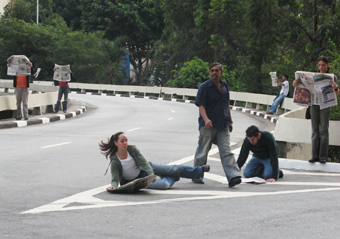
Out of Key(s), Opovoempé
photo Ana Carmen Foschini
Out of Key(s), Opovoempé
Opovoempé is a São Paulo theatre company whose agenda is focused directly on public space. Since its birth in 2005, the company has made a series of public interventions in locations including not just streets, fairs and squares, but also supermarkets, train stations and shop windows. Their works range from the overtly theatrical to the invisible, and draw on the legacy of cultural activism championed by the late Brazilian theatre maker, Augusto Boal. The company’s title (literally “people on their feet”) reflects its aims and “gives the idea of people moving, rather then riding or sitting. People in active existence or operation.”
The company states that their projects “aim to promote new relations between people and the space of the city, and are based in the exploration of the frontiers of the dramatic act.” With this premise they act to infiltrate chosen social settings to “subvert operating systems and alter the perception of participants.” Forty years ago such a statement may have made them a target for the Brazilian dictatorship, however these days their work resonates more as poetic provocation than political motivation and has received the support of the State Secretariat of Culture.
By offering new perspectives of shared space and interactions, Opovoempé illuminates the public lives of São Paulo residents and beyond. In doing so the company calls for vivid interaction with the spectator, to be “stimulated to perceive, see, imagine, interfere, create, act.” Such an active blurring of boundaries between art and life certainly fuels a fibrous artistic discourse and brings to mind the layered impact of Deborah Kelly and Jane McKernan?s powerful evocation of the Tiananmen Square protest, Tank Man Tango (RT93, p2-3).
With ever expanding public liability laws defining acceptable public activity, companies such as these three play an important role in questioning how we inhabit our environments and provide valuable stimulus for new perspectives.
I have always been intuitively committed to heightening the collision between theatre and life. Interacting with these companies in Brazil confirmed my belief in the critical need to deliberately exchange the space between the real world and theatre, in such a way as to confuse expectation. This may not only awaken the sleeper, but can also transform our cities and towns into places of social communion. By magnifying and directing performer ability to manipulate space, time and meaning, each of these companies illustrates the power of the individual to transform space and thought well beyond the walls of the theatre.
RealTime issue #97 June-July 2010 pg. web
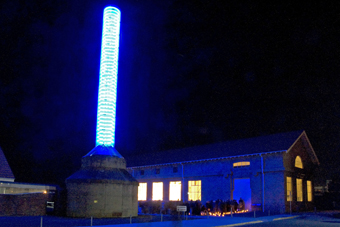
The Fitter’s Workshop
photo Peter Hislop
The Fitter’s Workshop
WALTER BURLEY GRIFFIN, THE ARCHITECT OF CANBERRA, ONCE WROTE THAT “A CITY IS FROZEN MUSIC.” ACCORDINGLY CHRIS LATHAM, THE DIRECTOR OF THE RECENT CANBERRA INTERNATIONAL FESTIVAL OF CHAMBER MUSIC, REFLECTED THE RELATIONSHIP BETWEEN MUSIC, ARCHITECTURE AND THE STRUCTURE AND FUNCTION OF THE HUMAN BODY IN A FESTIVAL EXPLORING DIFFERENT SPACES FOR PERFORMANCE AND DIFFERENT WAYS BODIES RECEIVE AND UNDERSTAND SOUND.
From Domenico de Clario’s all night piano vigil to a full performance of the Monteverdi Vespers, Latham placed concerts in venues ranging from the soaring atrium of the High Court to the angular, postmodernist foyer of the National Museum, to the low, sleek, domestic interior of the Swiss Embassy, a 1970s New Brutalist reverie in concrete and glass.
In this last venue, Swiss oboist Thomas Indermuhle illustrated the contiguity of these ideas on an intimate scale, showing how tonguing, rasping, buzzing, tapping and singing into the bore of the instrument can create a performance alchemy that makes wood sound like metal and the performance “feel quite vocal” to the performer.
Cordiality between performer and audience occurred even in the most vast of spaces, belying the fact that the majority of the 10 days of concerts were of unashamedly ‘high’ ambition and tone. The festival opened with the New Purple Forbidden City Orchestra—”China’s finest ensemble of traditional instruments”—with music “from the great dynasties of Chinese history” and poetry from the I Ching. These ancient ritual traditions unashamedly revere music as go-between of cosmic and material worlds. The nearly 30 concerts which followed honoured these aspirations in a series of prayers, praises and laments, trances, motets and incantations, the composer list—from Josquin, Aquinas, Bingen and Gesualdo to Beethoven, Bach, Mozart, Mahler, Messiaen and Takemitsu—reading like a who’s who of classical and pre-classical ‘greats’.
Of the living composers (for example, Ross Edwards, Sofia Gubaidulina, Rautavaara, Gorecki, Tavener, Sculthorpe), most aspire to a tone of epic reverence, with some (Sculthorpe and Edwards of course) also paying homage to landscape and western and indigenous histories. The sole minimalist on the program, Terry Riley, builds his work based on pitches and rhythms from ancient Indian traditions. His peers treat his work and the man himself as an inspiration and kind of saint.
If I have any lingering doubts about the festival, it would be the way its offerings resisted dark spaces. Even that Australian master of the macabre and the Grand Guignol, Larry Sitsky, was represented in more moderate incarnations, whilst Elena Kats-Chernin, her Motet wedged between several powerful, trance-inducing choral works by Arvo Part, played lightly on the edge of satire.
The festival’s ‘Gold’ theme reflects Latham’s focus on things precious, from water to gemstones to unguents such as frankincense and myrrh. Various rituals were at least referred to, if not performed: journeys towards marriage, to the underworld, to allaying death, or of the Magi. Some epic feats were achieved: from Mahler to Strauss and Wagner to Tavener within two days, under the baton of Roland Peelman, for the most part to very good effect and sometimes stunningly. Perhaps by focusing on ritual and beauty the festival asked its audience to focus its ears in very particular ways.
It was a canny move to program the Australian Baroque Brass to play and repeat its offerings in different spaces so that the audience could pay attention to variations in acoustics. A contemporary audience, already a little distanced from familiarity with the sounds of sackbut (literally “push-pull”—a predecessor to the contemporary trombone) and cornet brought curious ears to the short performances which, like a progressive dinner, moved from one type and size of building to another. We were treated to a kind of attunement, not just to what, but also to how we hear and give shape to interpretation.
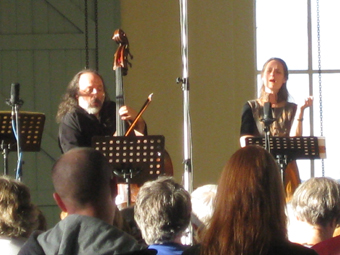
Jouissance, Kassia
photo courtesy of CIMF
Jouissance, Kassia
The Melbourne group Jouissance is exemplary in this aspect. The group creates dialogue between ancient chant and contemporary culture. Here their focus was the medieval Kassia, considered the first female composer whose scores are both extant and able to be interpreted by modern scholars and musicians. The group interacts with, rather than replicates, early work. Artistic director Nick Tsiavos says that studying postmodern theory in the 1980s made him think hard about contexts—what era we live in, what our own ears and experiences bring to any interpretation. The result is a performance philosophy that sees historical interpretation transformed by contemporary zeitgeist.
Tsiavos’s double bass sometimes breaks with jazz-influenced riffs; Peter Neville’s playing of contemporary, conical ‘Ausbells’ and simple, hung pieces of sheet metal carry medieval resonance but allow a sassy exploration of contemporary mood. Anne Norman brings her generous, elastically expressive shakuhachi into the fold (this is Byzantium via Japan), whilst Jerzy Kozlowski’s canonical bass resonates to our more secular sorrows. Deborah Kayser’s soprano breaks and dives and flutters in an extraordinary free-form exploration of, and improvisation around, the emotions of the mystic Kassia’s text. At certain moments, I am quite sure Kayser’s body has become a shakuhachi, mimicking its tonalities and technique (tonguing, fluttering, and shaking). This body and voice become the temple of Kassia’s prayers.
Significantly, Jouissance’s primary modality is improvisation, which was not a key element in this festival. Because this group is so practised in the art, it achieved alchemical transformations, which I would not say was always the case in the themed concerts such as “In Praise of Water.” It moved from composed mantras interspersed with improvised reveries, to one of Copland’s aching prairie-calls, to a very moving, but traditional rendition of Waltzing Matilda in a curious sequence that almost came off. By his third improvised interlude, Bill Risby developed some very interesting reflections on the preceding musical themes, yet I sat within an experience that felt thematically controlled, not musically released.
The standout in this very concert, however, by the festival’s resident composer, tells a different story. Ross Edwards’ The Lost Man (words by Judith Wright) is a delicate and demanding piece that sets up layers of listening in slow waves that build and recede and build again throughout. Edwards manages to gesture to the qualities and motions of water without pretending to make it. The piece harvested the piano; I heard it fill like a precious lake. Edwards writes about his compositional process as “an interplay of (materials) assimilated and interfused with sound patterns subconsciously gleaned from the natural world.” This suggests that for all his ideas, research and technique the composer allows something else to take over, relinquishing control.
It was good fortune the festival secured the Fitter’s Workshop, part of the 1920s Powerhouse Precinct in Kingston on the Lake foreshores of South Canberra—an enormous but welcoming, clear and fresh space of bright acoustic which many Canberrans hope to co-opt as a permanent performance venue. It was also exceptionally canny of Chris Latham to weave together the combined forces of amateur, professional and student choirs and orchestras—including the T’ang and New Zealand String Quartets, the Song Company, the Canberra Camerata, the forces of the School of Music, ANU—and other local professionals and composers, to weave a strong sense of support and community. The festival’s resources were bolstered by each concert having a personal sponsor from within the local community.
Much of the success of these concerts was due to the extraordinary abilities of Roland Peelman who could elicit both subtle and impassioned musical nuances from the professional and amateur instrumentalists, soloists and choirs, and somehow blend the voices. The grand finale of the Vespers, written in 1610, called for precise coordination between melismatic vocal lines and ostinato (provided by lute, contrabass and cello] and fine judgment in moving between different, complex groupings of voices, especially when in canon. The great unison “Amen” charged the room, as if the Age of Doubt, which began three centuries after its composition, never really happened.
In some concerts, but not most, one could feel the strain of attempting too much. Yet at their best, the combined forces achieved a translucent dignity—perhaps too the goal stated in Hexagram 16 of the I Ching: “harmony between Man, Earth and Heaven…a dance of Man with the Stars”.
Canberra International Festival of Chamber Music, May 14-23; www.cimf.org.au
RealTime issue #97 June-July 2010 pg. web
© Zsuzsanna Soboslay; for permission to reproduce apply to realtime@realtimearts.net
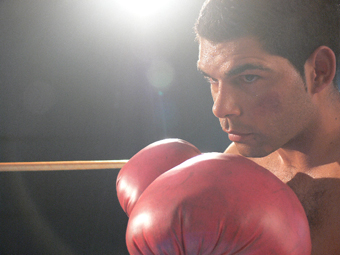
The Caretaker
THE SCREENING OF THE 2009 FILMS COMPRISING THE 11TH SERIES OF THE LESTER BOSTOCK INDIGENOUS MENTORSHIPS (NOW PART OF METRO SCREEN'S FIRST BREAK GRANTS SCHEME AS INDIGENOUS BREAKTHROUGH) WAS LAUNCHED BY THE MAN HIMSELF—A KEY PROGENITOR IN THE FOUNDING AND NURTURING OF AUSTRALIAN INDIGENOUS FILMMAKING IN THE 1980S AND 90S AT AFTRS AND METRO SCREEN. SINCE THE BOSTOCK MENTORSHIP'S INCEPTION IN THE 1990S 44 FILMS HAVE BEEN MADE AS PART OF THE PROGRAM.
Bostock, whose focus these days is on dealing with the challenges of disability in Aboriginal society (through the National Indigenous Disability Network), noted a long-term shift in Indigenous filmmaking from largely issue-based content to increasingly personal stories. However, he argued that “the only really political films” continued to be made by Aboriginals and with a distinctive filmmaking style.
Fault, directed by Martin Adams (mentored by Jason De Santolo), is immediately and cruelly suspenseful. An anxious, depleted man sits in a bleak room with a gun and the clack of a flip clock. 2:59. Cut to a laneway where we see him with a male friend. Cut to room. 3:11. The man looks suicidal. Cut to the man shooting his friend, accidentally, or so we think. There's a sharp knock on the door. We hear a gun shot. Cut to the man walking away with his friend, but time is out of whack—the man is now his younger self. At the moment of death he re-lives his lost friendship, even love perhaps. Fault is raw filmmaking, if spare and deftly edited. Its brevity and the focus on generating tension allow little room for character detail but its gritty mood (amplified by a grinding sound score between silences) and sense of loss is palpable.
Quarantine (director Tyrone Sheather, mentor Simon Portus) reveals a young couple in love, lolling on the grass beneath the looming stars, “together forever.” Their reverie is interrupted by a massive crash. The young man pushes through the bush to find a smouldering comet. As the couple approach it the world of nature evaporates into an enveloping whiteness out of which men in protective outfits with guns and hypodermic needles emerge. The couple flee, but shot and bleeding, they fall. One of the men announces the need to quarantine the area as soon as possible: the couple have been infected by an alien virus and duly eliminated to prevent its spread. Some of the effects are striking, other moments are awkward, the dialogue is stilted and the story lacks the touch of complexity that could have lifted Quarantine out of the morass of the sci-fi paranoia genre.
Stylishly shot in widescreen, Alanna Rose's The Caretaker (mentor Margot Nash) is an accomplished film which immerses the viewer in the world of the ageing Willie “The Kid.” Willie, critically not identified as such until the end of the film when he turns to reveal the lettering on his jacket, sits centre screen in a boxing ring in a darkened space, the spare, sharp light dancing with dust. Looking at old photographs which “come to life,” takes him back to his childhood. He and his brother, poor kids without a father, sneak into a boxing gym where they win the support of a trainer. Years later they crawl under a canvas into the world of tent boxing (a beautifully executed piece of editing in which we, with the boys, are confronted with a massive, gloriously red, beating drum).
Now grown up, the brothers are part of Australia's tent boxing world before it disappeared in 1971. Rain beats down as old Willie peers into his past. So far, we imagine The Caretaker to be in the tradition of the “could have been a contender” or “the down and out” school of boxing films. But the story here is even darker, one brother killing another with a calculated KO out of jealousy and ambition. Apparent nostalgia disturbingly mutates into real guilt. More than this, Willie, no longer a champion, has made himself look at his past.
While a couple of scenes are unnecessarily expository and the emotion is trowelled on at the end (an overlay of thunder and a good song with a strong hook), The Caretaker constitutes promising filmmaking from Rose and a strong cast and seriously expert crew. The film is dedicated to the memory of artist and filmmaker Michael Riley whose documentaries included Tent Boxers (1997). Alanna Rose has been awarded the 2010 Indigenous Breakthrough grant for $22,000 towards a film of up to 20 minutes and a range of support from Metro Screen.
Fault, writer, director Martin Adams, cinematography Fabio Cavadini, sound design, composition Grant Leigh Saunders, editor Peter Cramer, producer Jason De Santolo, actors Ken Canning, Scott Canning, Gio De Santolo, 4:50mins; Quarantine, director, writer Tyrone Sheather, cinematography Jack Anderson, sound Jason Dean, editor Peter Ward, producer Jack Anderson, actors Kay Cast, Dylan Underwood, 4:00mins; The Caretaker, writer, director Alanna Rose, cinematography Brandon Jones, production designer Brett Wilbe, editor Craig Savage & Oana Voicu, producer Jade Rose, actors Mick Mundine, DJ Mundine, Paul Sinclair, Kobi Hookey, Derek Walker, Tony Barry, Tony Ryan, Warwick Moss, 15:35mins; Lester Bostock Indigenous Mentorship screening, Chauvel Cinema, Sydney, April 20; www.metroscreen.org.au
RealTime issue #97 June-July 2010 pg. web
© Keith Gallasch; for permission to reproduce apply to realtime@realtimearts.net
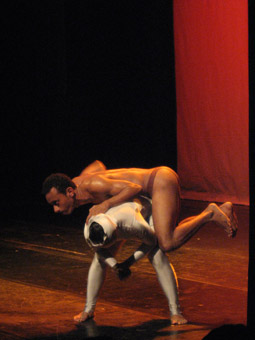
Merah
photo Phalla San
Merah
AT THE BEGINNING OF ASRI MERY SIDOWATI’S MERAH (RED), THE STAGE IS IN TOTAL DARKNESS UNTIL SEVERAL DIM LIGHTS ALLOW A GLIMPSE OF TWO FIGURES. WE SEE AN ALMOST NAKED MAN IN A LOIN CLOTH AND WOMAN WEARING A TIGHT DARK OUTFIT WRAPPED AROUND HER BODY FROM TOP TO ALMOST TOE, THE DESIGN MAKING IT IMPOSSIBLE TO SEE HER FACE.
In the background there’s a sound like a cricket, adding to a heightened sense of quiet. It’s as if we are being drawn into a jungle, but serenity brings with it a terrorizing kind of solitude. The stage is dark again. Gradually the sound changes to a kind of a heavy mumbling while scattered rays are slowly projected on the backdrop, like sunlight peeking through forest trees, but again suggesting stillness.
Originally a 2006 graduation piece, Merah was made during the hype of Al Gore’s documentary, An Inconvenient Truth. It tries to take us into the vortex of global warming, rain forest destruction and other environmental crises, although the elaboration of the work’s theme is not quite clear.
The almost naked man bends at the knees and crosses his hands in front of his chest, mimicking the flapping wings of a bird and symbolising hope or, perhaps, the birth of life itself. At first this ‘bird’ flies slowly and then faster and higher, so high that the man must let it go.
In another scene the stage becomes almost red, as if something bad is taking its course. The man squats as if great pressure is being imposed upon him, his hands pulled back, his face in grinning as if in pain. He bends lower and lower, moving slowly, meticulously transforming his pose, making the working of his muscles visible—a movement tradition rooted in the dance of Topeng Panji (Panji Mask) of West Java.
Towards the ending of Merah, the man wraps his body around the woman like a belt or a snake which she accepts with strength and without complaint. She bends as a vest descends, partially covered with broken mirrors. The man climbs onto her back and slips into the garment, scattering light through the theatre.
For the choreographer perhaps the male figure represents the human species while the woman is nature, bowing to man and subject to destruction. All aspects of the performance—its stillness, the low lighting and slow movement—conveyed haunting imagery if not making the work’s meaning finally clear.
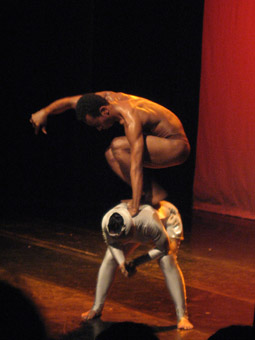
Merah
photo Phalla San
Merah
WHEN THE LIGHTS BLACK OUT IN INSTITUT KESENIAN JAKARTA’S TEATER LUWES ON THE SECOND NIGHT OF THE INDONESIAN DANCE FESTIVAL, AN ENVELOPING DARKNESS BLANKETS THE ENTIRE SPACE. IT’S EVEN MORE SUFFOCATING AS WE AWAIT MERAH, THE SECOND WORK ON THE PROGRAM. SOUNDS THAT YOU WOULD NORMALLY HEAR IN A FOREST OR JUNGLE IN THE DEAD OF NIGHT PIERCE THE DARKNESS. BUT WE SEE NOTHING, EVEN AS THE FAINTEST SLIVERS OF LIGHT GLOW ON THE STAGE.
The dancers are only very slightly illuminated by a smattering of light on the cyclorama that simulates moonlight shining through thick leafy branches. Because we had been in the darkness so long, I was not even sure if the second dancer, situated in an upstage corner, was indeed actually there; he seemed to blend into the cyclorama so much that my still-adjusting eyes were convinced that he was merely an image projected on the screen.
The other dancer, whom we later discover is Merah’s choreographer, Asri Mery Sidowati, stands at the opposite corner, nearer the audience. She is covered head to ankle in a shiny, metallic body suit. In contrast, the dancer upstage, who is not a hologram after all, is stripped down to the briefest of briefs. As he jaggedly moves to the sound of crickets and birds rustling through the night, it becomes obvious that he is meant to be of the earth—a primal version of man—while the figure wrapped in metallic cloth, who very slowly yet continuously moves her cradling arms in patterns around her body, might very possibly be otherworldly, a spirit but also possibly an alien. Given the costuming and my lack of knowledge of Indonesian mythology, it is difficult to determine which.
The male dancer has the more interesting movements: flexing and undulating, posturing sporadically in between, darting, flicking his fingers, shoulders and head almost as if in reaction to the sudden chirp of a cricket. After an eternity of this minimal movement from both figures, they edge towards one another, until they stand side by side with their feet wide apart. Together, they pull their heads back into a circular sweep, the man with his back to the audience, shoulders rippling with muscles as he does. Shortly after, they enter a common sphere, the man reaching for the wrapped figure and slowly wrapping himself around her midsection so they become one—an image sustained a little too long but allowing time for speculation. The man is not afraid of this otherworldly being, who, in return, readily accommodates him. After the performance, I overhear that she represents Mother Earth, but this didn’t occur to me at all since she moved into his space, merely visiting the world that he inhabited.
I see her instead as an external entity, and the male figure’s act of attaching himself to her as an exercise in empowerment, a kind of calling upon divine forces for strength. He climbs up on her back and is immediately garbed in a mirrored vest—a triumphant acquisition of power, exhilarating and uplifting, the glass shards flashing light over stage and audience. This invocation of a deity ends in triumph and frees man from the overwhelming, suffocating darkness with which the work began.
Later, however, I read the program notes and am entirely confused. It seems that Asri choreographed Merah as a commentary on Global Warming; the correct reading of the work would then be that grasping Mother Earth and stepping on her would be some form of abuse that she endures and even allows. The mirrored vest can then be read as an explosion of sorts—if we step on Mother Earth, we must be ready for the consequences. However, the work did not translate this threat clearly and, as I’ve pointed out, the tone of the ending was more inspiring than ominous.
Audiences may take whatever they wish from a particular work, and whether Asri likes it or not, her message will not always come across as intended. I applaud Merah’s journey from darkness to light, from gloom to triumph, and the slow, measured, unremitting pace that it took to get there.
![S]h]elf](https://www.realtime.org.au/wp-content/uploads/art/36/3671_giang_shelf.jpg)
S]h]elf
photo Phalla San
S]h]elf
IN THE MILD BLUE LIGHT OF THE DIM STAGE, TWO YOUNG WOMEN IN WHAT LOOK LIKE SWIM SUITS CRUISE ON WHAT APPEAR TO BE SHORTENED SURF BOARDS FRINGED WITH BLUE LIGHTS. SPINNING, GLIDING SOUNDLESSLY ON THE FLOOR, IT LOOKS LIKE AJENG AND ANGGIE ARE FLOATING IN A SWIMMING POOL, ENJOYING THEMSELVES ON A STARRY NIGHT.
S]h]elf, a collection of loosely bound short episodes, opens the second night of the 10th Indonesian Dance Festival. Next, the protagonists are busily quarrelling. Exchanging extra-large t-shirts they are soon entangled. Awkwardly bound they mouth Barbie doll interactions of the “I love you, but I hate you too” and the “Get away, but don’t leave me alone” kind. Welcome, say the program notes, to the world of South Jakartan, affable, middle-class youngsters.
Another scene has Anggie moving slowly from the periphery to centrestage, stopping after each little step, upper body leaning, shaking uncontrollably. Only her feet and fists are held firm, as if she wants to run away but can’t. She grimaces: is she crying or laughing? Is she drugged? It takes her an eternity to reach the front of the stage. Looking straight at the audience, she burps. “Give me a break. To hell with your social conventions,” she seems to say. In another episode, Ajeng turns a roll of toilet paper into a mock camera, ‘shooting’ the dozens of people in the audience whose cameras have produced endless clicking ever since the performance commenced.
Performed by Ajeng Soelaiman (born 1984) and Andara ‘Anggie’ Firman Moeis (born 1986), and choreographed in collaboration with Fitri Setyanigsih (born 1978)—all rising stars of the Indonesian dance scene—the work is fun, unfussy and has an air of ironic coolness. The set consists of two mobile glass revolving doors and metallic cubic frames hanging low from above, suggesting the worlds of entertainment and shopping. The performance is a self-portrait; drawing on their own lives the women play themselves, and they do so convincingly, with touches of self-irony.
What does it mean to be female, young, well-off and sophisticated in a Muslim society? At one point, Ajeng uses lipstick to draw a heart on glass, but her hand slips and the drawing becomes a confused mess of lines. Later, she stands in front of a glass door, facing the audience, in full evening dress. Radiating an amiable elegance, she bends to one side as if is about to dance. The music is a soothing, chill-out waltz. Gracefully, she raises her hand and gives the audience the finger. Or is the glass frame actually a mirror, and is she signalling self-disgust?
Whether rebellion or self-examination, it’s a fleeting gesture. At the end of the work, the two young women stand around a table of wine glasses, as if at a party. While Ajeng plays with two glasses, bored, pouring wine from one to another, Anggie, in a continuous slow motion loop, drains the dark content of each glass in a mouthful, throws the empty over her shoulder and reachs for another. There is no loud smashing of glass, no emotional crisis, no theatrical breakdown, just the embracing comfort of boredom. It’s the end of the party. Too tired for anything wild, the pair choose to stay in air-conditioned comfort, souls numb, surrounded by broken glass and broken hearts.
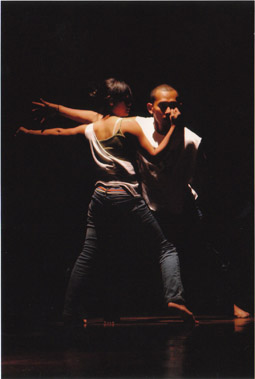
The Young
IN THE FINAL MOMENT OF THE YOUNG, A BOY AND A GIRL FACE EACH OTHER, BOTH WEARING A SNEAKER ON ONE FOOT, A SNEAKER ON ONE HAND. IN THE SILENCE YOU CAN HEAR THEIR PANTING. STRIPPED OF THEIR GRASPING AND POSTURING, THEY SEEM TO ACTUALLY SEE ONE ANOTHER FOR THE VERY FIRST TIME. THEN, TOO QUICKLY, THE LIGHTS CUT OUT.
To get to this final point of undemanding honesty, the dancers in Muslimin Bagus Pranowo's duet have to scrabble through a thicket of teenage angst. In a scene as bleak and empty as a nightclub after closing time, the two battle for the many pairs of sneakers littering the dim stage. The girl, performed by Maharani, wears the drainpipe jeans so favoured by the young. Hard eyed and hard mouthed, she gives as good as she gets. Being the first to wear one sneaker on her foot puts her in command. Wearing two sneakers, she assumes a tough-guy nonchalance, folding her arms and leaning on the boy as if on a sidewalk lamp-post, he bending in acquiescence.
The fast, aggressive movement, accompanied by a choppy and harsh electronic score, full of loud squawks and scratches, did not allow much leeway for subtle emotional expression. Nevertheless, the boy, performed by Muslimin, comes off as the more indecisive and piteous character, undermined by sexual frustration. Early in the work, he reaches through the girl's legs from behind and grabs her crotch, a gesture of aggressive lechery that she completely ignores. Later he fends the girl off and goes for a shoe, only to suffer sudden performance anxiety. When the girl lies on her back, sneakered feet in the air, he performs a short solo of agony; it is deliberately unclear whether he lusts after the girl or the shoes. When he finally does claim his own pair of sneakers, they fail to make him happy; rather than acquiring a sense of confident adulthood (feigned or not) as the girl did, he continues with the jumping, rolling, charging movement as if nothing has changed.
The sneakers are objects of fetishization, whose overt use—to protect feet—is overshadowed by their symbolic value: the possession of coveted material goods, the construction of an individual identity, maturity or sexual attractiveness. When they first encountered the shoes, both boy and girl were similarly perplexed. They seemed not to know what they were for, wearing them on their hands and pressing them to different parts of their bodies. What should be a display of bad breeding (proximity between shoes and heads in Asian cultures being extremely rude) is rendered instead as a moment of quiet intimacy. With the shoes to separate them, the pair touch each other as they otherwise cannot. Simultaneously, the thumping score descends into radio static, displacing the scene from the pressure of normal life. Suddenly realising what they are doing, the dancers freeze, then break away.
The movement vocabulary of The Young is appropriately transnational, almost unplaceable, but more similar to Western contemporary than any Indonesian cultural dance. Only one moment locates the movement within a distinctly Indonesian idiom. The two dancers crouch, proffering a sneaker with both arms fully extended towards the audience, their heads ducked down between their shoulders. In this stance one might present an offering to a king, especially if one had done something very wrong and was appealing for forgiveness. Oh, figure of authority, the dancers seem to plead, take away these shoes, this source of rancour and unhappiness that tortures us! But it is only a moment quickly washed away in an unrelenting wave of movement.
At 25 years of age, Muslimin already shows an easy ability to manipulate a variety of cultural movement vocabularies. The video projection element in The Young, however, was too diffuse and brief to have much impact, but the performers were confident and skillful, and the work explores a tightly coherent theme with insight and maturity. As part of IDF 2010's opening night, The Young is a strong representation from its namesake cohort as well as an illustration of the festival theme “Powering the Future.”
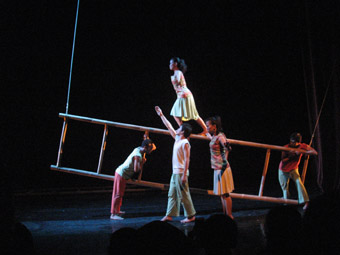
5,6,7,8
photo Phalla San
5,6,7,8
THE 10TH INDONESIAN DANCE FESTIVAL PROGRAM OF WORKS BY FIVE EMERGING INDONESIAN CHOREOGRAPHERS FOCUSED ON PERSONAL ISSUES INTERTWINED WITH THE VALUES AND NORMS OF INDONESIAN SOCIETY. THE CHOREOGRAPHERS COME FROM ART UNIVERSITIES AROUND INDONESIA: THE JAKARTA ARTS INSTITUTE (IKJ), ISI YOGYAKARTA AND UNESA IN SURABAYA.
Nur Sekreningsih Marsan’s 5,6,7,8 elaborates one person’s journey and their relationship with others. With ladders as the principal stage properties, the dancers are often placed in challenging circumstances. One part of the work requires two dancers to walk along the narrow length of the side of a ladder, the delicate balancing reflecting the difficulties faced in relationships.
Cekrek (Click) by Joko Sudibyo opens with a scene where a woman wearing a blue kebaya top and batik cloth sits down in the middle of a group in dim blue light. Her hair is pulled back and rolled into a big bun. It’s a look preferred by most Javanese mothers when posing for a family photo. Four young men wearing long sleeved white shirts stand before her. Slowly and gracefully, the woman stands. Gently moving to the right, she performs the subtle hand gesturing of Javanese dance. But as soon as she leave the stage, the four boys move about dynamically, the mood shifting from tradition to modernity.
This shift and its reverse occurs several times in Cekrek: in the next scene another man appears, bare-chested and wearing a batik sarong. He moves in traditional Javanese fashion with special precision and fluidity while the four boys circle around him. He then performs a duet with the woman in the blue kebaya before exiting. If she is an idealised mother the man appears to be a missing father figure.
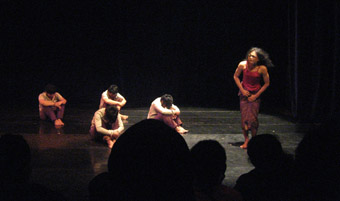
Cekrek
photo Phalla San
Cekrek
Next, another woman appears. Wearing a red tank top and batik skirt, she weeps with over the top exaggeration, complaining how hard she works and that the men in the family have done nothing to improve its condition. She represents the real life mother who is often frustrated by the family hardships.
Near the end, the idealized mother reappears, putting an abrupt halt to a chaotic situation. The real mother contains herself. The four boys tuck in their shirts, poke each other as though wanting to show the mother who’s to blame, and solemnly form a line with their mother. The idealized mother slowly sits and pulls out a camera. Without being commanded they all smile comically and wave politiely as their picture is being taken. One big happy family.
Cekrek very simply suggested the importance of the mother in a family. Her nonchalant presence is crucial, creating harmony while her absence yields chaos—a belief firmly held by most Indonesian families. The successful fusion of traditional and modern movement and its simple imagery made the dance a delight to watch.
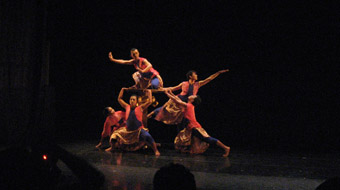
Gayaku
photo Phalla San
Gayaku
Shinta Maulita’s GAYaku focused on homosexuality. This piece couldn’t be more appropriate considering the current situation in Indonesia where the gay and lesbian movement is gaining momentum.
GAYaku opens with three men and a woman seated in a circular formation beneath another man sitting on top of a round platform. Squatting cross-legged, he flexes his right arm, making a gestures like those of deities in Hindu temples, while the other dancers circle him.
Live gamelan playing thickens the traditional ambience, with a male singer chanting in Javanese “a woman should be with a man; how it would be when a man decided to pair with a man, and a woman with a woman?”
GAYaku depicts the joyous decision of the men to embrace their sexual identity. Four men gather again in a circle, this time wearing glittering bamboo hats commonly used as rice baskets. They shake their bodies coquettishly, while forming a circle facing each other. One gestures as if applying make-up, his other hand holding an imagined mirror.
The festivities move into over-the-top celebration as the dancers invade the auditorium, shaking their bottoms. This “We’re gay and we’re proud!” mentality reflects life in many big cities in Indonesia where more and more men and women daringly come out, ‘boasting’ their gayness.
The last two works in this program were Retorika Kerinduan by Santi Pratiwi and Bunglon by Serraimere Boogie. The first is about urbanization, and the yearning to return to village life, while the other elaborates on the ability to adapt. Bunglon involved Papuan costume and a merging of Javanese and Papuan movement.
Overall this showcase of works by emerging choreographers demonstrates the effectiveness of dance education in Indonesia. It is also refreshing to see that tradition plays an important part in the work—having strong roots is always a good place to start.

5,6,7,8
photo Phalla San
5,6,7,8
WHAT? WHY? HOW? THE EMPTY STAGE IS A BLANK SLATE WHERE FIVE YOUNG INDONESIAN CHOREOGRAPHERS (FROM ART UNIVERSITIES AROUND INDONESIA: THE JAKARTA ARTS INSTITUTE (IKJ), ISI YOGYAKARTA AND UNESA IN SURABAYA) MAKE THEIR MARK. AMIDST MUSICAL CACOPHONY AND THE BLUR OF LIGHTS, LIKE ANYONE IN THE EARLY STAGES OF DEVELOPMENT THESE EMERGING ARTISTS SEE PATTERNS, QUESTION STEREOTYPES AND TRY TO FORGE IDENTITIES.
5,6,7,8
In the language of the dance world 5,6,7,8 means prepare. And you should, when a cycle of beginnings commences the moment the lights reveal two men bursting into explosive kicks and jumps to the creaking sound of straining wires. A ladder, over which the men move quickly and deftly, lies inertly on the floor beneath their feet.
In Nur Sekreningsih’s 5,6,7,8, sound loops shift from the resonances of traditional instruments to running notes on the piano to concrete sounds and back again. This musical history is mimicked by the dance movements, rotating between traditional, contemporary and folk, a formal construction that underpins the work’s theme: the cycles in relationships.
The dancers cover the space well with energetic leaps, conveying a strong sense of motion and interaction. Set higher and higher—on its side, sloping, suspended above the shoulders—the bamboo ladder allows varying forms of engagement and framing but is also a hindrance. The dancers are entertaining when they jump through the rungs or hang from the ladder’s uprights but, unfortunately, the increasingly precarious ‘tightrope’ act, performed at each level of the ladder’s positioning, misses the mark. The spectacle of the balancing act as the performer teeters on the edge of the ladder detracts from the image of the dancer as forward-looking—she is more tentative than progressive. Nor is it clear how this image of isolation relates to the cyclical nature of relationships.

Cekrek
photo Phalla San
Cekrek
cekrek
Exploring how family dynamics can affect identity, Cekrek is the poignant and humorous highlight of the showcase. Choreographer Joko Sudibyo’s choreography is an expert fusing of styles in which the wide stance, flexed feet and soft arms of Balinese dance combine with a jazzy influence evident in undulating bodies and quick rebounds off the floor. The all male cast confidently perform the steps, exuding a youthful precociousness that makes me smile.
Posing for imaginary portraits, four youths, neatly dressed in short sleeved, white collared shirts and brown trousers—a typical school uniform—freeze each time the lights flash. They are oblivious to the mother figure kneeling directly in front of them, her back to the audience displaying perfectly coiffed hair pulled back in a low bun and the blue lace of a Kebaya (blouse).
This woman rises gently and moves off-stage, the performer’s masculinity barely discernable, so delicate and poised are his movements. The eyes of the boys are glued to her as she exits but her absence releases them into a series of body waves—head, chest, belly, hips, lifted in successive sequences. They horse around, pushing and gesturing, isolated heads moving quickly from side to side, pointing (mostly with the middle finger), jabbing and thrusting, painting the air around them—their movements still suggestive of traditional dance. The boys appear to revel in their independence.
Is the bare-chested dancer who enters next a memory of an absent male authority figure? The four crouch around him as his back and extended arms move in sinuous ripples, as if jolts of electricity run through his veins. The ‘mother’ returns to the stage, and he dances with her in a strange duet, the relationship appearing to be that of human and ghost. He navigates the space around her, never making contact as she, seemingly unaware of his presence, makes her slow progress across the stage to exit. Then he too disappears.
Another female character enters, also a male dancer, this time with long wild hair, a pink tank top—showing off chorded muscles—and a traditional long cotton skirt tightly wrapped around the legs. This woman is a caricature, like a soap-opera mother. Unlike her silent counterpart, she wails melodramatically, stops abruptly turns to the audience, says she’s been “crying for three days” then resumes her squawking, half-dancing, half-sobbing around the stage.
Trying to shame the boys into reaction, this single mother (the program note explains that the woman is the family’s breadwinner) pulls her hair into a mad tangle, tossing and flicking it every which way, shouting in Bahasa that she deplores their ingratitude, for never thinking about her or the family. She yanks their heads back as she scolds and cajoles, but they ignore her, remaining inert, eyes closed. Later they gather behind her as she continues to jabber, pointing and gesticulating; naughty children mimicking a scolding parent.
Somehow order is restored when the genteel Kebaya-clad mother returns: the boys shuffle away, straighten their clothes and line up with the wild-haired mother. Suddenly, the genteel mother whips out a camera. Pasting on cheesy grins, cranky mother and sons pose for a portrait—the illusion of a happy family.
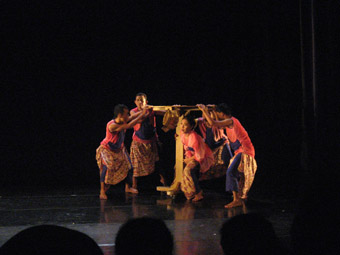
Gayaku
photo Phalla San
Gayaku
gayaku
This night’s program seems to be a re-contextualising of traditional Indonesian dance forms within a modern framework. Nowhere is this theme as clear as in GAYaku which starts quite traditionally—a man sits cross-legged, meditating on a shoulder high table under which people sit like ancient sculptures. From the edge of the stage traditional musicians play a haunting gamelan melody and chant in eerie unison. The dancers move through the strong poses characteristic of males in Javanese dance.
Part-way through, round gold, helmet-like hats with a protrusion on the crown are worn, then playfully cupped against chests, thrown in the air and turned upside down like bowls—Freudian symbolism perhaps of dual sexuality. Exploring the freedom of new gender identity, the male dancers perform traditional Javanese female movements; using soft fingers, vainly admiring imagined reflections, taking tiny, demure steps, they move the work to its campy ending.
To reach this freedom there must first be a moment of crisis. In the program note, female choreographer Shinta Maulita, writes, “I try to love the person I am supposed to love…but I can’t.” This might indicate that GAYaku is about Maulita’s frustrations, but it’s about much more. In a pair of duets, a male dancer partners Maulita. As they face each other, legs wide apart and hands outstretched, this traditional Javanese dance movement becomes the basis of missed kisses as the dancers’ faces bob and weave. The key image is of Maulita cradled, like a bride about to be carried over the threshhold. Lips almost meet but her partner’s eyes shift away, an expression of anguish and regret on his face. A male-male duet ensues, the dancers circling each other, legs moving closer but bodies stretching away in hesitation. In the end they embrace, faces frozen inches away from a kiss. Maulita’s work has brought the audience to the brink of a transition but by not taking the final step she keeps the work in the realm of pretense, and leaves the rest to the imagination.
In GAYaku, traditional movement becomes sexually charged: a basic shoulder roll, usually delivered slowly and with care, becomes a seductive shimmy; the wide legged walk with gentle hip sway turns into a booty shake as the dancers gyrate to the rhythm of the music. Finally, moving among the audience they blatantly flirt and tease, questioning and inviting.
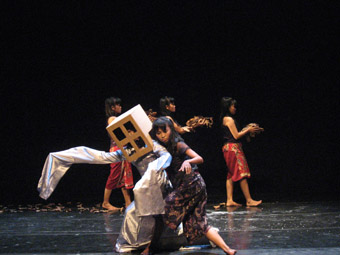
Retorika Kerinduan
photo Phalla San
Retorika Kerinduan
retorika kerinduan
Retorika Kerinduan is Santi Pratiwi’s discourse on increasing urbanization and the inability to assuage a longing for the old village life. A body is lit in the centre of the stage, no head or legs, just a back, naked but for streaks of metallic gold paint, pushing and heaving to ominous grating sounds. It is a man struggling to rise; distorted arms pushing outwards, he appears to be hatching from an egg. From deep in his throat come strangled sounds as he gasps for air. Kneeling in a semi circle, three women slowly bow their heads to the ground and, returning to the upright position, ritualistically repeat the movement. Perhaps the choreographer suggests that the worship of money is suffocating.
Near the middle of the work an image of human devolution appears. Almost as a footnote to a series of martial arts inspired, middling lunges and quick jabs, three dancers enter at varying heights, ranging from upright Homo Erectus to crouching monkey. The final image is of a silver robed figure with a cardboard box—shaped to represent a sky-scraper—on his head, a woman at his feet. Behind him the trio of women move as if in a funeral procession, dropping brittle brown leaves, mourning encroaching urbanisation.
bunglon
The final work, Bunglon (Chameleon), is an oblique criticism of the hypocrisy and Machiavellian attitudes of opportunists in politics and entertainment expressed through a mashing of cultures. The dancers are adorned with feathery headpieces and similar arm-bands. In a nod to hip-hop couture they hike up one pant leg and near the end of the work add a sneaker, while painted flames—vibrant tribal-like tattoos—lick up the sides of their exposed calves. Serraimere Boogie Yasson Koirewoa’s choreography is a reflection of this blending—hip-hop grooved traditional dance gestures. The images are not particularly symbolic but the permutations of movement formations suggest the easy adaptability of a reptilian species.
The movement language of the works in this program may not have been particularly original and I’m bemused by the overabundance of images and occasional mixed metaphors. Most of the pieces rambled in their search for cultural and individual identity, but this is a forgivable short-fall in the work of young choreographers. They were well served by a high level of physicality and commitment from all the dancers. These choreographers are off to a good start in defining their styles. Perhaps I was impatient only because youthful confusion is catching.
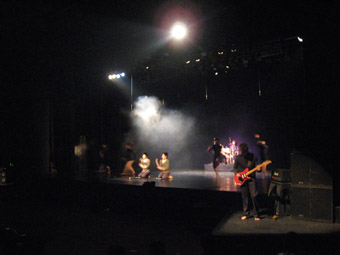
Darkness Poomba
photo Phalla San
Darkness Poomba
DARKNESS POOMBA BEGINS WITH TWO MEN STANDING STILL IN LOW LIGHT. ONE PLACES HIS HAND ON THE OTHER’S FACE; HIS COUNTERPART RESPONDS WITH THE SAME GESTURE. THE INCREASINGLY FAST ACTION BETWEEN THE TWO IS ACCOMPANIED BY THE STRONG VOICE OF A SINGER OCCUPYING THE SAME SPACE AS THE AUDIENCE. HE PERFORMS A TRADITIONAL WORDLESS SONG USED FOR FESTIVE OCCASIONS AND ALSO BEGGING. SUDDENLY, STRONG LIGHT REVEALS DANCERS RESPONDING WITH LIVELY MOVEMENT TO POWERFUL RECORDED MELODIES AND THE LIVE SINGING. BRIGHT LIGHT ALTERNATES WITH SOFT AND THE DANCERS MOVE SLOWLY TO THE FORCEFUL RHYTHMS OF THE SINGER. AT THE END LIVE ELECTRIC GUITAR, BASS AND DRUMS COMBINE WITH THE POWERFUL DANCING TO GENERATE A GREAT SENSE OF EXCITEMENT.
This is Darkness Poomba the last of four contemporary dance works performed to celebrate the opening of “Powering the Future”: the 10th Jakarta International Performing Arts Festival (IDF). The audience cheered, clapped and rocked to the 11 young dancers, musicians and vocalists from South Korea directed by choreographer and composer Kim Jae Duk who also performed as dancer, musician and singer. The combination of elements was dynamic and vigorous—while my hands were busy taking notes, my head and torso unconsciously swayed.
Beneath bright lights, the dancers committed body and limb to fast moves, shaking and leaping in a combination of modern dance, breakdance and acrobatics alternating with slower movement. From the moment the dancers were joined by the guitar players and drummer the work became larger and more dramatic. While the stage was filled with dynamic dancing, the choreographer joined the singer in one aisle of the theatre, singing and playing a mouth organ, while the two men who opened the show repeated their slaps and grabs at speed in the other aisle. The audience clapped and swayed, screaming their satisfaction.
The perfectly synchronized dance movement in Darkness Poomba and the beautiful and powerful live music made for an attractively dramatic and dynamic work. Although titled Darkness Poomba, the strong lighting not only distinguished between scenes but also suggested a brighter spirit.
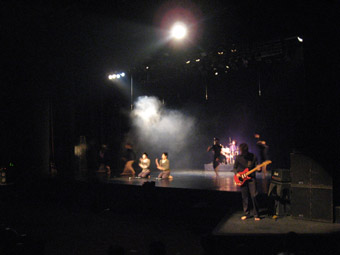
Darkness Poomba
photo Phalla San
Darkness Poomba
AN EERIE, LOUD NOISE WAS HEARD DURING THE INTERMISSION FOR THE OPENING DAY’S MAIN PERFORMANCES AT THE 10TH INDONESIAN DANCE FESTIVAL (IDF). PERHAPS IT NOT ONLY SIGNALED THE AUDIENCE TO RETURN TO THEIR SEATS, BUT ALSO HINTED THAT KIM JAE DUK PROJECT’S DARKNESS POOMBA FROM KOREA WOULD LOOK AND SOUND VERY DIFFERENT FROM THE INDONESIAN CONTEMPORARY DANCE WORKS IN THE FIRST PART OF THE EVENING.
As the house lights dimmed and the curtains parted, we saw an electric guitar and bass on either side of the front of the stage, and upstage centre a drum set—to the delight of many dance audiences who prefer live to canned music. No musicians though. As two dancers moved downstage centre, we became aware of a singer behind a microphone in the house right aisle. The lyrics were in Korean, we thought, and that’s when some of us couldn’t help ignoring them, despite the singer’s vivacious hand gestures. And so music might suddenly become noise. Later on, the musicians took their places and, for a brief moment, the dancers stopped moving, giving the focus to the music.
Most of the time, though, the performance was multi-focus, attempting as it did to involve the audience—one dancer came down from the stage and up the house right aisle to sing and play instruments, while another two used the left aisle as their main stage. We were encouraged by the performers to clap along, and many of us did, and that’s perhaps when we felt we might have forgotten some dance-going etiquette. Then again, such restraint was established by Western classical ballet companies, and this is Korean contemporary dance.
Darkness Poomba is an example of how a unique intra-cultural experiment has led to engaging contemporary performance. This is thanks, in major part, to the fact that the choreographer and composer Kim Jae Duk has found, and emphasized, links between contemporary dance and an ancient singing tradition, Poomba—in which rhythm plays a stronger role than lyrics which, as a Korean tourism website explains, don’t mean anything. Although the performance was explained in the festival’s printed program as “composed of 70% of dance and 30% of music”, the union of the two was such that it became “100% of contemporary performance” which reminded us of the relationship between dance and music, and how artists have been trained concurrently in many disciplines thoughout the history of many performing arts traditions.
It’s perhaps also another reminder that although many Asian contemporary choreographers look to European and American counterparts, sometimes they can just look back to, and ‘re-search,’ their past. It may also be confirmation that although ‘modern’ equates with Western in many Asian countries, ‘contemporary’ is totally different.
Presented at an international festival, Darkness Poomba may also trigger our curiosity about the Poomba tradition. As the tourism website suggests, we can visit the National Pumba Festival every year in the town of Eumseong, to see and hear how the actual traditional street performance with funny make-up and costumes, or Lightness Poomba if you will, lifted up Korean spirits in poverty-stricken times.
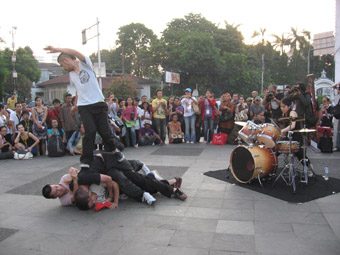
Contact Gonzo and Sayaka Himeno, public space
photo Phalla San
Contact Gonzo and Sayaka Himeno, public space
A few hours earlier, it was a young Japanese group contact Gonzo’s street dance performance that served as the soft opening—and a fitting one indeed—for the four-day festival. As about 100 people gathered around Plaza TIM, at the entrance to the host institution, noise from a bustling Jakarta street provided ambience that thematically fit the highly physical performance that was reminiscent of the street fights that takes place daily in many cities around the world. This was complemented by exuberant drumming, on a drum kit, by a female musician who, interestingly, rarely glanced at the four male dancers chasing and attacking—without actually hurting—one another. And occasionally we heard water bottles dropped and rolled around the cement floor. And unlike in Poomba, this soundscape didn’t set the rhythm of the dance, but rather added to the street ambience and the meaning of the piece.
Of course, many of us are still delighted to see contemporary dance works set to European classical music played to a live audience on CD, but, as a connotation of the term ‘contemporary’ suggests, there are also many other possibilities. After all, unlike theatre which is usually associated with, and powered by, spoken word that limits overseas exposure, contemporary dance speaks with body movements and music, or, as in these two cases, noise.
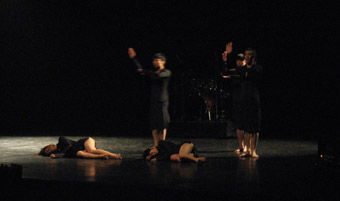
Darkness Poomba
photo Phalla San
Darkness Poomba
TWO MALE DANCERS IGNITE KIM JAE DUK’S DARKNESS POOMBA WITH A DUET PERFORMED BENEATH SEVERE TOP-LIGHTING. IT’S A FAST AND FURIOUS EXCHANGE OF ANGULARLY CHOREOGRAPHED MOVEMENT, HANDS MECHANICALLY GRASPING FOR EACH OTHER’S FACES AND BODIES REGIMENTED IN A FORWARD FACING STANCE. CREATING AN ILLUSION OF A ROBOTIC PAIR OF SIAMESE TWINS, THE TWO STYLISH YOUNG MEN ARE JOINED BY FIVE DANCERS CLAD IN CHIC BLACK SHARPLY ENTERING TO JOIN THIS MACHINE, EXPANDING ON THE GOTHIC ENERGY THAT HAS BEEN GENERATED.
A spot picks out a man standing with a microphone in one of the aisles. Ears and eyes are immediately drawn to this powerful presence and we are captivated as the space swells with his chanting of the traditional Korean Poomba (a wordless street song associated with both begging and festivities), evocative of desperation and yearning. Manipulated reverberation suggests that we are all inside a cold and mysterious vault of some sort, suspended between hallucination and reality. The performer displays extraordinary command of his instrument, and his sensitive commitment to the dancers on stage helps them to devote themselves to the dark abrasiveness of the space.
Later in the work, a dance with metallic dinner trays between the two male dancers who opened the piece brings an oddly domestic sensibility to the abstract world that has been established. The trays become percussive instruments as well as hats and items of clothing. The chorus of dancers behind them acts as a strata of strange shadows that morph from one contained image to the next. The dance is realised with crisp articulation and un-wavering performance energy as if the dancers are teasing out the dark underbelly of this work with a quiet ferociousness.
The darkness of this rich work is both deeply set in the bones of the performance and ironically woven into its surface. Even when the whole audience claps and sings in delight when the work turns into a rock concert, the haunting atmosphere never lets up. In fact it is in these ‘light’ moments that the gothic undertone is somehow heightened, demonstrating a sophisticated approach to the creation of atmosphere. Funereal organs and regular smoke machine emissions are both parodic and unsettling.
When choreographer and dancer Kim Jae Duk joins the vocalist in the auditorium and two electric guitarists play at either end of the stage, the traditional lilt of the Poomba becomes the wailing power of a rock concert, the guitars providing the metallic grit for the transition. The audience too has been transformed, from theatre spectators into a rock stadium crowd.
In a return to the opening duet, the two dancers perform a gradually accelerating version of the robotic Siamese twin dance down the aisle towards the stage. This phrase cleverly functions as the peak of the work, causing a kind of ‘Mexican wave’ effect on the crowd, evident in a vocal eruption. After the excitement has subsided, a gentle, virtuosic harmonica solo is performed by Kim Jae Duk, cleverly returning us to the work’s opening eeriness. As the creator lays his final delicate mark, the piece closes.
Not one sense is privileged over another in this haunting re-contextualization of the traditional South Korean melody of Poomba. In a truly interdisciplinary and multi-layered work, audience members are taken on a strange and unexpected voyage through the realms of contemporary dance, traditional song, stadium rock and festive reggae. Perhaps seeming schizophrenic and disjunctive in nature, this collage of performance genres is in fact executed seamlessly. Darkness Poomba is a work that manages to constantly transform our environment before we have even noticed, each new world functioning as a critique of the one that has come before.
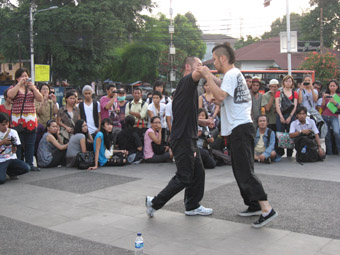
contact Gonzo, Public Space
photo Phalla San
contact Gonzo, Public Space
FIGHTING ERUPTS ON A CONCRETE PLATFORM ON THE EDGE OF A BUSY JAKARTA STREET, FOUR MEN GRAPPLING WITH EACH OTHER, PILING BODIES INTO PRECARIOUSLY PERCHED PYRAMIDS, CONSTANTLY INVADING EACH OTHER’S SPACE, SLAPPING AND PUNCHING. THIS IS NO ORDINARY STREET BRAWL BUT A PERFORMANCE BY JAPANESE COMPANY CONTACT GONZO THAT PUSHES THE PERFORMANCE BOUNDARIES BOTH PHYSICALLY AND LITERALLY. AT ANY MOMENT THE PERFORMERS COULD SPILL INTO THE WATCHING CROWD, AN IMMINENT DANGER THAT FORCES THE AUDIENCE TO PHYSICALLY ENGAGE IN THE WORK AS THEY DODGE AND RECOIL IN ANTICIPATION.
This work was one of the two international offerings that contributed to the youthful exuberance of the 10th Indonesian Dance Festival. The other was Korean Kim Jae Duk’s Darkness Poomba, bombarding the senses with a fusillade of fast movement combined with loudly belted lyrics and a beat that had the audience swaying and clapping.
Equally engaging, the two performances could not have been more different in execution and philosophy. Contact Gonzo doesn’t employ many theatrical tricks for its street performance, just the performers, an unamplified drum kit and simple props—water bottles, caps and disposable cameras. Although part of a dance festival, the physical language used cannot be comfortably labeled; it more closely resembles sport than dance in its raw action and response. In contrast, Darkness Poomba employed a full range of theatrical devices; strong lighting states to highlight the action, sleek costuming to show off the dancers’ physiques, sound amplification and a self-conscious breaking of the spectator-audience divide.
Kim’s youthful energy as performer, composer and choreographer, drives the piece, particularly when he commandeers the microphone showing off his strong voice or plays soulfully on his harmonica. Self-described as 70% choreography and 30% music Darkness Poomba is both rock concert and contemporary dance performance, crafted to get the blood pumping and body bouncing. This is a “re-mix” of Korean Poomba music, a throw-back to when the country was impoverished and street singers roamed around to entertain in exchange for food and money, singing the meaningless but rhythmic word “Poomba.”
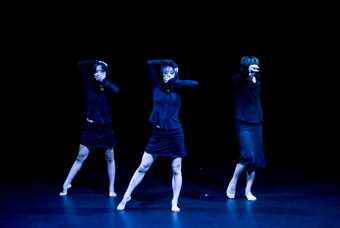
Darkness Poomba
photo Phalla San
Darkness Poomba
The work opens with two dancers lying limp in the centre of the stage. Suddenly they spring up, two young men, hair flopping over their eyes, dressed like dancerly beggars in earth-tones, they survey the audience then launch into a series of complex gestures, covering and uncovering their faces, then each other’s, hands threading through one another, then twining to catch hold and push their heads down. Imprisoned within the dark confines of the stage and the low groaning of the music, this depressed tone is short-lived because when the same sequence repeats some time later, it maintains the needlepoint accuracy yet, forced on by the driving beat and hyped up rock concert atmosphere it builds into a lightning speed that has the audience cheering.
Towards the end of the work the initial male pair re-appear moving metal dinner trays and bowls around with quick, concise movements and playing them as percussive accompaniment. Then like savage dogs they tear into imagined food, their beggarly appearance and hunger a reference to the history of Poombas.
The evocative, gestural movement vocabulary of the two sets them apart from the rest of the company, as Kim’s choreography for the black-clad dancers is a cross of liquid, contemporary movement and the aggressive energy of hip hop, that demonstrates strong ballet training without using a balletic vocabulary. The dancers are all long legs with broken torso lines and body distorting gestures that sharply accent the music and punctuate the strong beat.
Their figures perfectly synchronised, the dancers move as precisely as a well oiled machine. Bombarding the audience with speed of movement that denied emotional engagement, the physical prowess of the performers was admittedly inspiring. One male jumped high, smashing his leg into the air and completing a full revolution before landing, but did this stunt serve any other purpose than to wow the audience? The choreography was kinesthetically pleasing but not emotionally engaging.
It was the music that carried emotional resonance, particularly in the hoarse cries that emanated from the singer. This took on a life of its own as it travelled around the theatre, originating in one corner of the stage then moving to another, blaring and retreating like an auditory game of hide and seek. Later in the the work, a drummer sat centrestage, two guitarists flanked the stage and three dancers ran into the auditorium. They appeared to be escaping audience scrutiny but actually carried it with them, enlarging the performance space, if taking focus off the dancers remaining on stage.
One particularly powerful moment involving the pair of floppy-haired Poombas highlighted the challenge to the confines of the space. They threw themselves to sprawl flat against a side wall and then slowly peeled off. This was an undeveloped, token exploration of the space, part of an apparent mish-mash of images and ideas. However, in the spirit of entertainment that comes with Poomba, every moment was crafted to please, as when all action came to a stand-still and the drummer had his moment in the spotlight with a vibrant solo.
Contact Gonzo takes similar advantage of the power of energetic rhythm. From the first clang of the cymbals, the drummer is a dynamo of energy, going to war with the drum set. Echoing this aggression the dancers actually trade slaps, the smacking sound they create making the audience wince.
Aptly named after a style of journalism that is part fiction, part fact, in their performed battles Contact Gonzo negotiate a fine line between play and reality. Looking like young lion cubs in a mock hunt, they balance between careful control and risky stunts. With little formal dance training to share between them there is no polished technique, but a primal language of expression emerging from their improvised performances, making the action raw and naked. The construction of the movement revolves around the vigilance of the performers, highlighting the image of the hunt as they circle each other or attack with a sudden lunge or a slap only to be countered with paw-like swipes.
By conventional standards this performance may not be considered aesthetically pleasing, but like the journalistic style it is named after, it favours gritty delivery over polished accuracy. And the fact that this could escalate to violence at any minute makes it riveting. The unpredictability manifests in many ways, a randomly thrown bottle, water splashing around or the appearance of a disposable camera. At one point they give the camera to a group of watching boys and pose. The overlap of the two groups (performers and spectators) makes a touching picture when juxtaposed with playful violence.
Finally the drumming builds to a climax, forcing the dancers to increase their level of physical engagement until with a final crash of the drums the actionl freezes, and although the dancers still eye each other, alert and on their toes, the performance is over by common consensus as the audience breaks into applause. Contact Gonzo’s Yuya Tsukahara may have deliberately rebelled against theatrical conventions, but like Kim his focus is on involving the audience.
Here are two shows that travel very different paths to the same outcome: one taking full advantage of the effects a theatre offers, the other peeling production back to minimum, yet both create an immediacy that turns observer into participant. The explosion of energy that comes from the speed, risk and bone jarring sounds that these artists produce evokes a visceral response in the audience body making these works inescapably engaging and affecting.
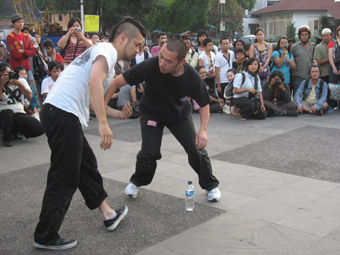
contact Gonzo, Public Space
photo Phalla San
contact Gonzo, Public Space
THE STREET FIGHT BUILDS SLOWLY. TWO YOUNG MEN IN STREET CLOTHES SLOWLY GROW AGITATED, PUSHING EACH OTHER, MOVING IN CIRCLES, EACH AGGRESSIVELY EYEING THEIR FIGHT PARTNER, BUMPING, STAYING GLUED TOGETHER FOR LONG PERIODS LIKE WRESTLERS. SOON TWO MORE MEN ENTER THE ARENA, AND WHAT STARTED LIKE A HARMLESS GAME—LIKE KIDS HANGING AROUND A TRAIN STATION, MEASURING THEIR STRENGTH OUT OF BOREDOM—HAS MOVED ONTO THE EDGE OF A REAL CONFRONTATION WHICH COULD GET OUT OF CONTROL AT ANY MOMENT.
The afternoon street performance by contact Gonzo provided a remarkable un-official opening for the 10th Indonesian Dance Festival. It caught me completely off guard. Expecting something of a hip-hop or breakdance show on the street, which might be even fused with a dose of traditional dance—the kind of thing offered later in the evening program just before the politicians delivered their opening speeches—I was hit by surprise.
The men move in and out of the fight, the physical intensity rising and ebbing with heavy breathing, water drinking, resting and watching followed and heightened by punching, slapping and wrestling. As the male fight continues, the ‘Greek’ chorus is a solo percussionist, aptly enough, a woman. Her intense drumming somehow gives the riot a dramatic element, turning it into a coherent struggle.
Contact Gonzo is a Japanase performance group that has been slowly gaining international attention. Before forming the group in 2006 and inventing the performing method of the same name, their members had been doing inspiring things like rolling down hills, catching falling leaves or jumping from the tops of telephone booths. With Gonzo meaning “bizarre, unconventional or extreme”, the performers transformed the technique of “contact improvisation”, incorporating the bumping of soccer, Sumo-inspired wrestling and a little known Russian martial-art called Systema with the ordinary kicks and punches and hits and spits from the street. Each performance is completely improvised, if with a few rules about what’s allowed and what’s not. There seemed to be some hidden communication or timing pre-arrangement with the drummer since without eye contact, she was in synch with the building up to and ending of the climaxes.
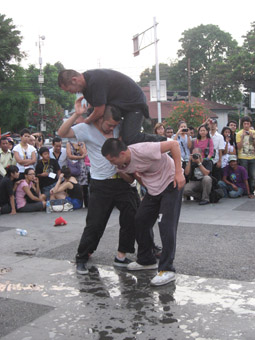
contact Gonzo, Public Space
photo Phalla San
contact Gonzo, Public Space
Some of the most beautiful moments occur when all four performers pile up on each other like a rugby scrum, frenetically interacting, agonizing, scanning the situation and making decisions about the next move in split seconds. The acting is so realistic that it reminded me of sessions of male bonding, most recently seen in the movie The Hurt Locker: violent, macho men horseplaying until emotions get out of hand and the unexpected happens. Meanwhile, the drummer is absorbed in her playing, working madly on her set, turning out sheets of sounds, which provide almost a physical stage for the men.
Contact Gonzo blurrs a few lines. Is it a staged show or does the aggression become real as the show progresses? In the middle of the tumult, somebody at the bottom of the pile grabs a disposable camera and shoots the performance. Here the artists criss-cross the delicate line between absorption and reflection. And are the audience mere spectators? Sometimes the turbulence moves dangeroursly close to the watching crowd. At one point, one performer falls at the feet of a group of street kids, who instantly take charge, grab the plastic camera and shoot.
The speed and rawness of contact Gonzo takes one’s breath away. As the performance comes to its end and the men rise to their feet and the drummer relaxes, I feel like I’m being released from an intense concentration, the kind you normally have when anticipating the unexpected.
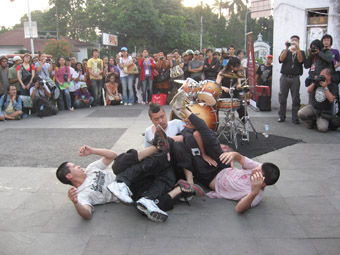
contact Gonzo, Public Space
photo Phalla San
contact Gonzo, Public Space
FOUR YOUNG JAPANESE MEN CASUALLY ENTER THE STAGE WHILE THE HOUSE LIGHTS ARE UP. THEY ARE WEARING T-SHIRTS AND TRACK-PANTS AND HAVE PERFORMANCE PASSES AROUND THEIR NECKS. ONE IS CARRYING A BACKPACK, OTHERS HAVE WATER BOTTLES AND THERE IS A VIDEO CAMERA ON A TRIPOD. THEY COULD WELL BE MISTAKEN FOR BACKSTAGE HELPERS PREPARING THE STAGE FOR THE NEXT ACT, BUT AS THEY EMPTY THEIR POCKETS, SET OBJECTS ON THE GROUND AND BEGIN TO WARM UP, IT BECOMES CLEAR THAT THEY ARE NOT. THEY ARE CONTACT GONZO, A JAPANESE DANCE GROUP.
For a few minutes they pace, lunging, stretching arms out every now and then, not in a dancerly fashion but as though about to run a 100m sprint. The physical and mental preparation generates suspense—the audience wondering what the heck is going on.
Eventually two of the men connect, not in the sense of contact improvisation where physical connection is utilized to explore movement, but rather as in sport or combat. They push and tussle, climbing on top of one another, every now and then dropping away to reposition, grab a drink of water or take a photo with a disposable camera. Gradually the battle escalates and without warning one strikes another in the face, the sound of palm to skin cutting through the air and triggering horrified gasps from the audience. The shock is amplified as suddenly from behind a backlit cyclorama a drummer improvises wildly. Crashing, banging, attacking, showing the drum-kit who’s boss, her huge, ominous shadow is an intriguing backdrop to the onstage male brawn.
An everyday performance paradigm coupled with the invitation to raw violence instils an immediate sense of the unconventional. Contact Gonzo take their name from the rebellious Gonzo journalism made famous by American journalist Hunter S Thompson. The exposure of what is normally hidden from an audience—the warming up, setting up, drinking—parallels the raw and un-edited subjectivity of the Gonzo style of writing, in which grit is favoured over polish. Thompson documented his own actions while immersed in journalistic projects, a reflexive technique also evident in Contact Gonzo’s use of cameras on stage.
As the performers wrestle, a cell-phone rings in the audience. A number of people nearby show their disgust with forceful shushing, but one of the performers reassures them, “No it’s okay. It’s okay.”
More violent slaps to the face are thrown from every which way, more piles of bodies rise up, tumble and loudly crash to the floor. At times the fighting looks like a casual urban realization of traditional Sumo wrestling. Contact Gonzo battle on, but to what end? A highly charged testosterone display gratuitously taking advantage of theatre space to flex a bit of muscle? There is no emotional narrative here. The performers just are. They fight.
It’s no surprise to me that this young team of performers are currently being invited to perform in festivals all over the world, despite the work appearing to be more an uncontrollable event rather than a finely-crafted performance. It is clear however that this group has a precise agenda, and their unique antics ensure that they stand out from the rest of the program.
Contact Gonzo is a highly innovative ‘dance’ company who unabashedly challenge established theatrical norms. Representative also of a contemporary consciousness in which violence and technology are mutually implicit, I’m sure their work will act as an interesting reference point in critical dance discussions for years to come.
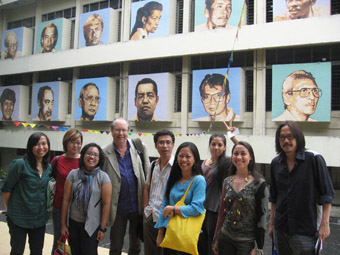
l-r: Devi Fitria, Melissa Quek, Dinyah Dinyah Latuconsina (Cultural Program Assistant), Keith Gallasch, Giang Dang, Joelle Jacinto, Cat Ruka, Bilqis Hijjas, Pawit Mahasarinand
photo Phalla San
l-r: Devi Fitria, Melissa Quek, Dinyah Dinyah Latuconsina (Cultural Program Assistant), Keith Gallasch, Giang Dang, Joelle Jacinto, Cat Ruka, Bilqis Hijjas, Pawit Mahasarinand
THANKS TO AN INVITATION FROM FRANK WERNER, REGIONAL HEAD OF THE CULTURAL PROGRAM DEPARTMENT AT THE GOETHE INSTITUT INDONESIA, I WAS DELIGHTED TO ATTEND THE 10TH INDONESIAN DANCE FESTIVAL (TITLED “POWERING THE FUTURE”) IN JAKARTA TO RUN A REVIEW-WRITING WORKSHOP FOR THE INSITITUTE IN RESPONSE TO FOUR DAYS OF EXHILARATING DANCE FROM INDONESIA, TAIWAN, JAPAN, KOREA AND EUROPE.
Amidst the festival hubub, new cuisine experiences, nerve wracking city traffic and World Cup tensions (after all, our host was a proud and anxious Goethe Institut), the workshop team saw shows, discussed and wrote (late at night or early in the morning), read each other’s reviews and shared knowledge and opinions.
The workshop participants were a fascinating mix: some had professional dance and producing experience, some were already reviewing, running blogs or contributing to magazines and newspapers, others were starting out.
Cat Ruka from New Zealand is a dancer, performance artist and the editor of Yellingmouth, an Auckland-based dance review blog. Melissa Quek from Singapore is a choreographer, a teacher at LASALLE College of the Arts
and a freelance dance reviewer for The Business Times. Joelle Jacinto from the Philippines is a dancer and a freelance writer with many years of experience. She is editor-in-chief of Runthru, a bi-annual dance magazine and website. Bilqis Hijjas creates, performs, produces, teaches and writes about contemporary dance in Kuala Lumpur, Malaysia and runs a residency for choreographers at the private arts centre Rimbun Dahan. Devi Fitria is a Jakarta-based journalist who works for the Indonesian art magazine ARTI and an online history magazine, HISTORIA. San Phalla lives in Phnom Penh, holds degrees in Southeast Asian Studies and archaeology and works as a researcher for Khmer Arts, a Cambodian classical dance company that tours the world. Dang Giang, from Vietnam, is a writer and cultural and social activist.
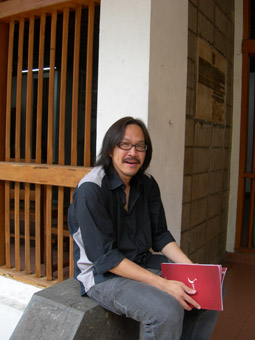
Pawit Mahasarinand
photo Keith Gallasch
Pawit Mahasarinand
Parwit Mahasarinand, a theatre lecturer and dance reviewer since 2000 for The Nation English language newspaper in Bangkok, was a very welcome addition to the workshop after he’d delivered a keynote address (“If we write more—Observations on contemporary dance criticism in Asia”).
Dance scholar, archivist and writer Franz Anton Cramer (Paris/Berlin) delivered two talks, one on the ethics and aesthetics of criticism and the other an invaluable and subsequently hotly debated introduction to the works of Meg Stuart and Philipp Gehmacher who were performing Maybe Forever in the festival.
The aim of the workshop was to improve the capacity of reviewers to vividly evoke the works they experience for their readers. Good reviewing (whether or not it consciously includes social, political and economic perspectives and passes critical judgment) cannot work effectively without this skill. Openness, strong recall, rich vocabulary, a structured response, the careful delivery of judgment, these were the workshop focus.
I was pleased that all participants willingly and bravely committed themselves to a challenging task—to respond very quickly to new dance works while focusing on writing skills and being subjected to criticism. As you read the reviews posted here do keep in mind that they were written under pressure and with limited time for editing and polishing. Despite these demands there are fine examples of vivid and thoughtful writing to be found in the 23 reviews that came out of a mere four days of what appeared to be happy labour. It was particularly pleasing to see increased attention not just to movement details but also to music, sound, set design, lighting and the ways in which, in this era of hybridity, various forms mix and meld.
The festival provided challenges for all of us in the workshop. Many works drew on traditional dance, customs and beliefs, sometimes leaving us guessing as to specific meanings while fascinated with what we seen. It’s doubly difficult given that the works are themselves contemporary interpretations or re-workings of traditional forms. Sometimes one of our number had an answer, or we googled one, provisonally, knowing that a dance festival like this one can only serve as an introduction to unfamiliar forms. Inevitably we debated the advisability of reviewing works where we lacked cultural understanding—would we misrepresent what we saw or were we encouraging interest and a sense of inquiry?
![l-r: Giang Dang, Phalla San, Joelle Jacinto [outside theatre]](https://www.realtime.org.au/wp-content/uploads/art/37/3701_gallasch_idf3.jpg)
l-r: Giang Dang, Phalla San, Joelle Jacinto [outside theatre]
photo Keith Gallasch
l-r: Giang Dang, Phalla San, Joelle Jacinto [outside theatre]
Other issues discussed included the significance, or not, of English language dance reviewing in Asia, a shortage of good editing, and a certain reviewer caution about being judgmental—verbal opinions were often tougher than those that appeared in print, said a number of participants.
From the too real street fighting of contact Gonzo to the contemplative account of a relationship breakdown in Maybe Forever and on to a range of works that engage simultaneously with traditional Indonesian forms and contemporary ideas (about homosexuality, globalisation, identity, climate change), you’ll discover in our workshop reviews an Indonesian dance festival engaged directly with the role of dance as art, and as life.
It’s hoped that the workshop will further the bringing together of dance artists and writers in the region.
The initials of the workshop writers will link you to their reviews of the following works:
Kim Jae Duk Project, Darkness Poomba [South Korea]: PS, CR, MQ, PM
contact Gonzo [Japan]: CR, GD, PM, MQ
Gusmiati Suid, Seruan [Indonesia]: DF
Asry Mery Sidowat, Merah [Indonesia]: JJ, MQ, DF
Muslimin B Pranowo, The Young [Indonesia]: BH
Jecko Siompo, From Betamax to DVD [Indonesia]: PS, MQ, JJ
Eko Supriyanto, Home: Ungratifying Life [Indonesia]: JJ, MQ
Vincent Sekwati, Barena ‘Chiefs’ [Indonesia]: MQ
Shinta Maulita, GAYaku [Indonesia]: DF, MQ
Ajeng Soelaiman, Andara Firman, S]h]elf [Indonesia]: GD
Cross Over Dance Company, Middle [Taiwan]: BH
Meg Stuart, Philipp Gehmacher, Maybe Forever [Berlin/Vienna]: BH, CR, GD, JJ, PM
Joko Sudibyo, Cekrek [Indonesia]: MQ, DF
Closing Night Performance: JJ, MQ
Emerging Choreographers Program: MQ, DF
You can see all 23 reviews at 10th Indonesian Dance Festival: Goethe Institut Regional Critic Workshop
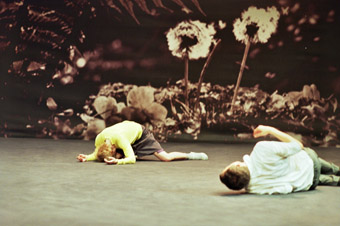
Maybe Forever, Meg Stuart, Philipp Gehmacher
photo Chris van der Burght
Maybe Forever, Meg Stuart, Philipp Gehmacher
IF YOU USED AN EXCITEMENT METER ON MEG STUART AND PHILIPP GEHMACHER’S CONCEPTUAL DANCE WORK MAYBE FOREVER, YOU COULD BE SURPRISED TO FIND THAT THE GRAPH YOU PLAN TO POST ON A WEBSITE, LIKE THOSE OF TWEET VOLUMES MANY SPORTS WEBSITES ARE USING, MAY LOOK QUITE FLAT. BUT THIS IS CONTEMPORARY PERFORMANCE IN WHICH, UNLIKE SPORTS EVENTS, WHAT’S HAPPENING DURING AND AT THE END OF THE SHOW MAY BE NOT SO IMPORTANT AS THE EFFECT ON THE AUDIENCE AFTERWARDS.
The stage of the Graha Bhakti Budaya auditorium is framed by semi-circular curtaining and is almost bare except for a low platform stage right, two microphones on stands, an electric guitar and a loudspeaker stage left, in addition to, upstage with a strong presence, a sepia photograph with two dandelions in focus against a background blur of trees. Stuart and Gehmacher begin with a slow duet amidst a brief series of low flashing lights. And that may be when the excitement graph rises to its highest. Stuart’s subsequent monologue—sweet sentences abruptly changed by the end clause “I take that back”—fills in the back story of a break-up.
What’s remarkable throughout the 80-minute performance is Stuart and Gehmaher’s frequent shifts to and from and blending of stage acting and dance, as well as from everyday to choreographed movement—the combination never risks being labelled pedestrian. One repeated gesture is what Stuart calls “long arms” in which the performers extend their arms and hands as high as they can to wave at each other. It’s like a special code that means something dear to the couple when they’re together but is painful after the split.
The same smooth mix of performing arts disciplines—in addition to life and art itself—is also evident in Niko Hafkenscheid’s live guitar playing and singing and Vincent Malstaf’s music and sound design. The music and lyrics are as melancholic as the performance, and since Hafkenscheid directly addresses us, they are sung for both performers and audience. After calling our attention to the performance at the start, Jan Maertens’s lighting design simply, and subtly, gives the limelight to the performers. His masterful touch shows at the final moment when the lighting delicately changes the photograph’s colour tone.
Heraclitus had it right two and a half millennia ago: change is the only constant. It just seems to me that when it comes to contemporary relationships, we change much faster than our patience.
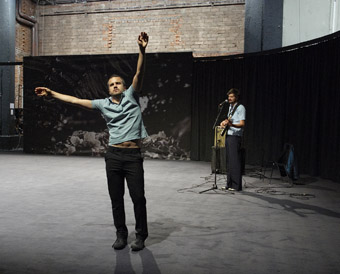
Maybe Forever, Philipp Gehmacher, Niko Hafkenscheid
photo Eva Wordinger
Maybe Forever, Philipp Gehmacher, Niko Hafkenscheid
What’s much more important than—I admit it—my failed romances is that in the 10th Indonesian Dance Festival it’s refreshing to watch a work by veteran artists who leave enough space for us to fully immerse ourselves in the work, add our interpretation to it and partake of individual journeys. After all, our experiences in failed romantic relationships vary. Monotonous can be engaging, mournful invigorating and mundane extraordinary. Such is life, and so is love.
One may argue that people go to performing arts events to experience what they cannot in real life—or, enough of early 20th century realism, please. In dance, they expect exceptional movement skills, for example. What they seem to forget is that sometimes we let life pass by without really thinking about it. Reconfirming that art is rooted in life, Maybe Forever allows us to do otherwise and hopefully, as we move on, not repeat a mistake, though knowing in the back of our minds that we probably will.
Maybe Forever is on a Southeast Asian and Australian tour, organized by the Goethe Institut, despite the fact that none of the artists are German (though Stuart is Berlin-based). Unfortunately, the only part of our country it crossed was the Gulf of Thailand last week on the group’s flight from Ho Chi Minh City to Singapore. Maybe Forever would have been a sizeable dance top-up for Bangkok audiences after the visit of Xavier Leroy last November.

Self portrait: From the outside, inside and beyond, 2009 (oil on canvas), Juan Ford
courtesy the artist
Self portrait: From the outside, inside and beyond, 2009 (oil on canvas), Juan Ford
WHAT HAS BECOME OF THE GENRE OF PORTRAITURE IN THE DIGITAL AGE? WHAT ACTUAL WORKS HAVE ARTISTS MADE IN RESPONSE TO THAT VAGUE LIST OF USUAL SUSPECTS WE ALL AUTOMATICALLY REEL OFF WHENEVER CONTEMPORARY MEDIA TECHNOLOGIES ARE MENTIONED: SOCIAL NETWORKING SITES, MOBILE PHONE CAMERAS, 3D SCANNERS, RAPID PROTOTYPERS, TOMOGRAPHY, AND ON-LINE AVATARS? PRESENT TENSE AT THE NATIONAL PORTRAIT GALLERY ANSWERS THAT QUESTION WITH A DIVERSE COLLECTION OF STRONG WORKS BY 27 WELL-ESTABLISHED AUSTRALIAN AND INTERNATIONAL ARTISTS, WHICH ARE INSTALLED WITH INTELLIGENCE AND WIT.
It’s good to see a show of photography and digital media which has been fully thought through and tightly selected by a proper curator, Michael Desmond, who has a broad knowledge and an international horizon. This show is a refreshing change from those loose surveys ‘around’ themes which appear to be chosen mainly for their convenience, or even worse, those ubiquitous but lazily conceived competitions which we get too often.
A good way of looking at Present Tense as a whole is that it is about the interaction of new technologies with the traditional methods of portraiture—painting, sculpture and photography—which already have their own pre-established ‘grammars.’ Thus we have Australian Jonathan Nichols’ flat, though engaging, paintings of young girls, each with a slight air of ambiguous familiarity. But wait, these aren’t paintings of the girls themselves, but of their Facebook thumbnails. The tug we feel is not towards their offering of themselves to us as individual viewers, but to the generalised gaze of the worldwide social network.
In another breathtaking remodalisation of an old technology, both Chuck Close (US) and Aaron Seeto (Australia) work with daguerreotypes, that primeval photographic process where all of photography’s uncanniness seems to manifest itself most magically. From a 21st century perspective, Close’s daguerreotyped heads and bodies remind the viewer somewhat of holograms. And as viewers move their head from side to side to get the right angle, and the image wells up from the visual depths like a surfacing whale, that familiar tingle up the spine they get, that simultaneous feeling of proximity and distance, is no longer configured historically—back into the depths of the mid-19th century—but existentially, from one human presence to another. In contrast, Aaron Seeto’s daguerreotype translations of right-click grabs from web reports of the 2005 Cronulla Riots make a more overt, even arch, point about the permanence and impermanence, the legibility and illegibility, of historical memory when it is entrusted to the oceanic swirls and currents of the internet.
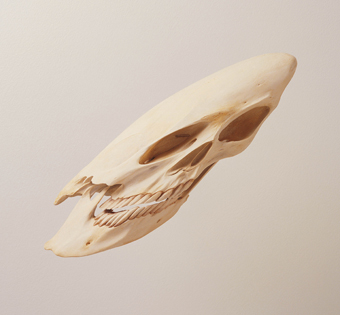
Skull, 2000, Robert Lazzarini resin, bone, pigment
courtesy of the artist and Deitch Projects
Skull, 2000, Robert Lazzarini resin, bone, pigment
The viewer has to do fair bit of head wiggling in this show. Installed across from the daguerreotypes there are two anamorphic skulls, both referring to Holbein’s famous vanitas intervention at the lower edge of his 1553 portrait of The Ambassadors. In a diptych the painter Juan Ford (Australia) bravely confronts an X-Ray of a skull. From our point of view, in front of the diptych, the skull is safely distorted and in another space. But, we realise, from his point of view within the diptych it would be restored to its correct, archetypal shape of warning and fear. The American Robert Lazzarini’s anamorphic skull is a life-sized three-dimensional sculpture made of actual bone material embedded in resin. As we circle warily, it fleetingly looms out of its anamorphic parallel universe and into our own.
In a similar way, the faces of Justine Khamara’s (Australia) angry and surprised parents suddenly pop out at us when we stand directly in front of the bulging aluminium constructions on which their flat images have been printed. It is the viewer’s exact position at the apex of the constructions which animates them, seemingly jolting them out of some kind of two-dimensional repose.
This show foregrounds the fundamental image-making actions which have now become proper to contemporary portraiture. It’s no longer just the snap of the camera’s shutter or the incremental description of the painter’s brush, but is also the trundling progress of the flatbed scanner and the circular pan of the 3D scanner.
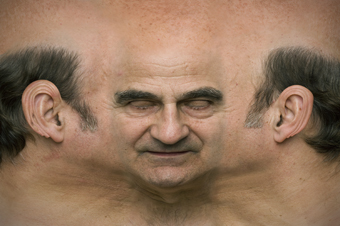
Stretched skin, 2009, Stelarc, type C photograph
courtesy of the artist and Scott Livesey Galleries
Stretched skin, 2009, Stelarc, type C photograph
Stelarc (Australia), in classic techno-narcissist style, stretches the skin of his head across a flat acrylic table measuring 1.2 by 1.8 metres, to invite us to delectate on every one of his pores and bristles. The German artist Karin Sander makes exact, three dimensional, indexical sculptures of her subjects at one-fifth scale by using three-dimensional scanning and rapid prototyping technology. What are these mini-them’s? Three-dimensional photos? Optical clones? Plastic avatars? Whatever they are, one isn’t enough. I found myself wanting the artist to be true to her namesake, August Sander, and methodically create an army of miniature German people.
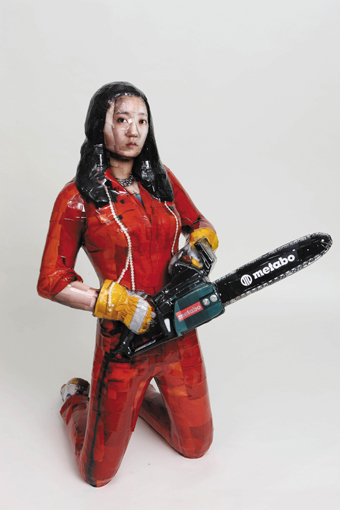
Metabo, 2009, Osang Gwon c-prints, mixed media
courtesy of the artist and Arario Gallery, Seoul
Metabo, 2009, Osang Gwon c-prints, mixed media
In contrast to the indexical, technologically produced three-dimensional portrait, the Korean artist Osang Gwon takes hundreds of small photographs of every inch of her young, punky, Korean subject and glues them on to a hand-carved life-sized Styrofoam figure in a loose collagistic style. This produces a strong but unstable sense of the physical presence of her subject, as if her skin and clothes, and indeed her whole persona, is on the verge of peeling away with nothing left beneath.
There are plenty of hits of humanist sympathy to be had from this show. In 2008 the Dutch artist Geert van Kesteren collected mobile phone shots SMS-ed out of Iraq and Syria. Enlarged, framed and gridded up the wall, these ephemeral and off-the-cuff images become a monumental document of geo-political conflict where snapshots of happy family gatherings and friends at play sit insouciantly beside shots taken out of the windows of moving cars of dead bodies by the road or the interiors of burnt out houses.
The masterful Dutch photographer Rineke Dijkstra provides the emotional centre of gravity for the show. Her simple nude photographs of startled young mothers clutching their newborn babies like bags of shopping about to burst remind us again of the power of the straight photo. But her stunning two-gun video installation, The Buzzclub, LiverpoolUK/Mysteryworld, Zaandam NL, also from the mid-90s, confirms the pre-eminence of the video portrait. Dijkstra has, presumably, momentarily pulled young off-their-faces clubbers straight from the dance floors and put them in front of her video camera in a bare white space off to the side. But the laser lightshows and the doof doof are obviously still going on inside their skulls. As they continue to work their jaws and jig robotically we get full voyeuristic access to them and, even though their interior individualities have temporarily gone AWOL, we nonetheless feel an extraordinary tenderness for them welling up.
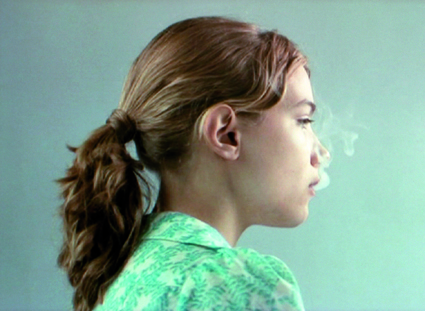
Ghost in the Shell, 2008 (video still), Petrina Hicks
courtesy the artist
Ghost in the Shell, 2008 (video still), Petrina Hicks
The theme of interior and exterior slowly emerges as a thread in this show. For instance Scott Redford videoed fellow Australian artist Jeremy Hynes performing a private, improvised homage to Kurt Cobain by writing his name on a cigarette and inhaling its now transubstantiated smoke deep into his lungs, before sobbing with genuine loss and longing. In a sucker punch for the attentive reader of the catalogue we learn that Jeremy Hynes was himself killed in a road accident a few months after the video was shot. Across the way from this projection is another Australian piece, Petrina Hicks’ Ghost in the Shell, where we silently circle around a pure, innocent young girl—or perhaps she rotates before us? Then, ever so discreetly, ever so elegantly, a tendril of smoke or mist escapes from between her lips. Her spirit? Her soul? Just her ciggy smoke? She continues to rotate without answer.
In the end this is a humanist show, about ghosts more than shells. It argues that despite all of the cold digital technology in the world portraits are still about the promise of finding the warm interior of a person via their exterior. The show’s inclusion of some three-dimensional ultrasound images of foetuses in the womb could have easily been over-the-top and obvious in its point about our intimate adoption of new imaging technologies. Until we see one intrauterine image of twins in which one foetus is caught sticking its toe into the eye of its sibling. A rivalry which, we think to ourselves, will no doubt continue for the rest of their lives.
Present Tense: An Imagined Grammar of Portraiture in the Digital Age, curator Michael Desmond, National Portrait Gallery, Canberra, May 14-Aug 22; www.portrait.gov.au/site/exhibition_subsite_PT.php
This article first appeared online, July 12, 2010
RealTime issue #98 Aug-Sept 2010 pg. 38
© Martyn Jolly; for permission to reproduce apply to realtime@realtimearts.net
australians win rolex arts awards
Congratulations to composer Ben Frost and dancer Lee Serle on being chosen for a year of mentoring in the Rolex Arts Initiative. Each year the program awards six mentorships to outstanding emerging artists working in dance, film, literature, music, theatre and visual art. This year, rather remarkably, two of the six awards were given to Australians. In the music category, Frost, a 30-year-old composer, producer and musician originally from Melbourne but now based in Reykjavik, will be mentored by the composer Brian Eno. You might have heard Frost’s music in the Chunky Move productions Glow, Black Marrow and Mortal Engine, or his album Steel Wound. In the dance category, Lee Serle, who is 28, will be mentored by renowned American choreographer Trisha Brown. He graduated from the VCA in 2003 and has appeared with Lucy Guerin Inc and in Chunky Move’s Mortal Engine, I Want to Dance Better at Parties, Two Faced Bastard and I Like This. His choreographic credits include A Little Murky and I’m in Love.
Given the pair’s connection with Chunky Move, artistic director Gideon Obarzanek is understandably delighted. Though Frost and Serle are Australia’s third and fourth Rolex protégées, they are the first from the live arts categories as well as the first Victorians. The previous Australian winners were both novelists from New South Wales: Julia Leigh, mentored by Toni Morrison in 2002-03 and Tara June Winch by Wole Soyinka in 2008-09. Frost and Serle will each be mentored across a year and in addition will receive US$25,000 and be eligible for a further US$25,000 to create a project in the subsequent year. Rolex Mentor & Protégé Arts Initiative
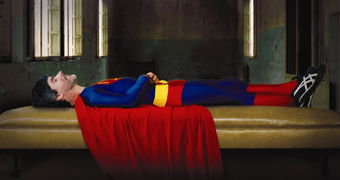
Paolo Castro, Superheroes
photo RODEO
Paolo Castro, Superheroes
everyday heroes & superheroes
Everyone loves a hero, flawed or otherwise. If you prefer them humble and homemade, then you’re bound to be pleased by NightTime State Wide: Everyday Hero. Like previous NightTime programs (see RT78 and RT91). Everyday Hero is an evening of short, live artworks curated by Lara Thoms and, this time, Jess Olivieri. Created by emerging and established Sydney artists such as John A Douglas, Renny Kodgers, Julie-Anne Long, Jason Pitt with Jade Dewi, Natalie Randall, Justin Shoulder, Anna Tregloan with Rita Kalnejais, and David Franzke and Alice Williams, the evening explores a range of everyday heroes: stay-at-home mums, unconventional fathers, child starlets, and even yourself (you get to try on a superhero costume). If you missed them in June at Performance Space, then you can see these heroes in action at Tamworth Regional Gallery (July 31), Lake Macquarie City Art Gallery (October 16), and Orange Regional Gallery (September 4).
Further south, in Adelaide and then Melbourne, theatre company Stone/Castro is going one better with their new show Superheroes. It begins with six characters in a rest home on the road to recovery and perhaps the road to salvation, or maybe domination, depending on which way they turn. Their battle for supremacy in this new, rather unlikely, territory serves as a microcosm for a larger “reflection on the complexity of globalisation, the future, violence, and war” (Press Release). Director Paul Castro, originally from Portugal but now based in Adelaide, is building a solid reputation on the back of productions such as Regina vs Contemporary Art (see RT89) and with No Strings Attached Theatre of Disability’s Tom the Loneliest (see RT88). NightTime Statewide: Everyday Hero, Performance Space and Hazelhurst Regional Art Gallery, curated by Jess Olivieri and Lara Thoms, Tamworth Regional Gallery, July 31, Lake Macquarie City Art Gallery, Oct 16), Orange Regional Gallery, Sept 4. http://www.performancespace.com.au. Stone/Castro, Superheroes, Space Theatre, Adelaide Festival Centre, Adelaide, July 20-24, www.adelaidefestivalcentre.com.au; Arts House, Melbourne Aug 11-15; http://www.melbourne.vic.gov.au/ArtsHouse
wollongong starfuckers
From heroes to stars …Wollongong isn’t a place you’d typically expect to find Starfuckers but then Malcolm Whittaker and Laura Caesar aren’t your typical stars: Whittaker is performance artist and collaborator with Team MESS (see RT90), and his partner Caesar is a primary school teacher and “arts and craft enthusiast.” Starfuckers is a durational performance of four hours (you come and go as you choose) which “deconstructs and (literally) reconstructs a ridiculously long list of lovers into an increasingly tangled scene of arts and crafts and diary dialogue.” It’s about how we represent relationships culturally, how we respond to those representations personally, and how those responses in turn shape our interpersonal relations. Presented by the new entrepreneurial arm of the Merringong Theatre Company, the Independent Producers Program, Starfuckers plays for two nights only. Bob Peet Studio, Illawarra Performing Arts Centre, Wollongong, July 23-24; http://merrigong.com.au/shows/stars.html
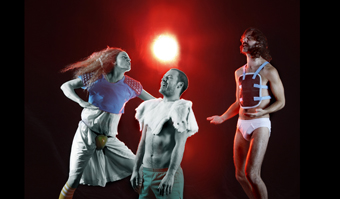
Kristy Ayre, Timothy Harvey, Luke George, NOW NOW NOW
photo Jeff Busby
Kristy Ayre, Timothy Harvey, Luke George, NOW NOW NOW
luke george: dancing in the moment
In Luke George’s NOW NOW NOW at Melbourne’s Dancehouse, the choreographer and two fellow dancers will attempt to address a paradox shared by performers and audiences: “We seek to be in the moment, yet through the pursuit of this, we move further and further away from it.” George began his career with Launceston’s Stompin (where he was also artistic director 2002-08), trained at the VCA and has worked with Phillip Adams’ Balletlab, Jo Lloyd, Chunky Move, Itoh Kim, Miguel Gutierrez and Deborah Hay. He has choreographed for Stompin, Back to Back and Arena theatre companies, and his independent work LIFESIZE (seen at Dance Massive in 2009) was short listed for an Australian Dance Award. In NOW NOW NOW he will be joined by dancers Kristy Ayre and Timothy Harvey with design by Bluebottle 3 and dramaturgy by Martyn Coutts. George writes, “My aim is to magnify audience/performer relationship and question the ‘realness’ of performance and how we are in the world. In NOW NOW NOW the performers are not characters representing a greater humanity or society—we are ourselves and this performance is a genuine attempt at the question, ‘can we be in the moment?’ and we invite an audience to experience that with us.” You can read Sophie Travers’ interview with Luke George about his career and vision in RealTime 98, August-September. NOW NOW NOW, Dancehouse, Melbourne, July 28-Aug 1; www.dancehouse.com.au
fact, uk: the reoriented gaze
Liverpool’s Foundation for Art and Creative Technology (FACT) is currently staging an exhibition titled Persistence of Vision. Featuring eight contemporary artists, including AVPD (Denmark), Julian von Bismarck (Germany), Julien Maire (France) Mizuki Watanabe (Japan) and Melik Ohanian (France), the show investigates “the relationship between vision, memory and media.” (Intriguingly, the exhibition appears to anticipate the theme for next year’s Performance Studies International conference, which is called Camillo 2.0: Technology, Memory, Experience. Camillo 2.0: Technology, Memory, Experience, Performance Studies International #17, Utrecht, the Netherlands, May 25-29 2011; http://psi17.org/) In one installation, In-Between Gaze (2010), Mizuki projects an out of focus image onto a wall. When the viewer uses a magnifying glass to bring the image into focus, a live video showing the viewer holding the magnifying glass appears in the focused part of the projection. In this way, “viewers not only see themselves, but also see themselves seeing.” The work by AVPD is similarly playful: “a disorienting installation using mirrors and corridors to explore the role of memory in our visual perception and orientation in a given space.” Persistence of Vision, FACT, Liverpool, UK, June 18-Sept 5; http://www.fact.co.uk/about/exhibitions/2010/persistence-of-vision
situating abramovic at artspace
Amelia Jones, author of Body Art/Performing the Subject (1998), Irrational Modernism: A Neurasthenic History of New York Dada (2004) and Self Image: Technology, Representation, and the Contemporary Subject (2006) among other books, comes to Artspace on July 13 to speak on “Performance as Improvisation: Aesthetics, Live Art, and the Problem of History.” The presentation will investigate “what happens when performance gets put in the frame of aesthetics.” More specifically, it examines Marina Abramovic’s Seven Easy Pieces (2005; http://www.seveneasypieces.com), where the artist re-enacted six 1970s performance art works (on the seventh day she rested) at the Guggenheim Museum in New York. Jones uses this performance as a “pivot” point in order to “argue that making ‘performance’ as ‘art’ is a category confusion that produces a range of contradictions, opening up a gap between aesthetics and the vicissitudes of the improvisational or the live event.” No doubt there are additional layers to the argument in view of the recent Marina Abramovic retrospective at MoMA, where numerous performers “re-performed” some of her early works (you couldn’t see it live, see it online at the exhibition website; http://www.moma.org/interactives/exhibitions/2010/marinaabramovic/index.html). No bookings will be taken for this event and places are limited, so get to Artspace early to avoid disappointment. Amelia Jones, “Performance as Improvisation: Aesthetics, Live Art, and the Problem of History,” Artspace, July 13, 6.30pm, http://www.artspace.org.au/public_lectures
RealTime issue #97 June-July 2010 pg. web
© RealTime ; for permission to reproduce apply to realtime@realtimearts.net
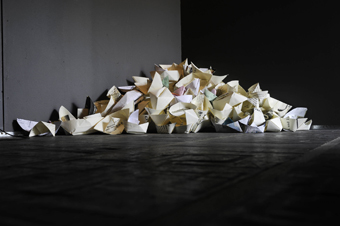
In Search of the Inland Sea, 2009, Norie Neumark, Maria Miranda
photo Adam Hollingworth
In Search of the Inland Sea, 2009, Norie Neumark, Maria Miranda
MEMORY FLOWS IS AN ONGOING PROJECT OF THE CENTRE FOR MEDIA ARTS INNOVATION (CMAI) AT THE UNIVERSITY OF TECHNOLOGY SYDNEY (UTS). UNDERTAKEN BY A LOOSE COLLECTIVE OF UTS STAFF AND AFFILIATED ARTISTS (OFTEN IN COLLABORATION), MEMORY FLOWS EXPLORES THE IDEA OF WATER AND ITS RELATION TO MEMORY, UTILISING SOUND, VIDEO, PHOTOGRAPHY AND SCULPTURE. SINCE ITS INCEPTION THERE HAVE BEEN SEVERAL PUBLIC OUTCOMES SUCH AS AT LIQUID ARCHITECTURE 2009 WITH THE PROJECT CULMINATING IN AN AMBITIOUS EXHIBITION PRESENTING 13 WORKS AT THE NEWINGTON ARMORY CURATED BY NORIE NEUMARK, DEBORAH TURNBULL AND SOPHIA KOUYOUMDJIAN.
The Newington Armory itself is quite a curious place—an eerie post-colonial ghost town left standing amidst the industrial sprawl of Silverwater (right next to a high security prison) on the mangrove fringed Parramatta River. On weekends it’s frequented by families as a leisure park with bike riding and roller-skating along the riverbanks. Approaching the Armory site it’s impossible not to contemplate the role of rivers in our ecosystem, the impact of modern civilisation on the landscape and the hidden histories of Sydney, and indeed Australia. Inside the exhibition, it is the works which approach these ideas more obliquely which prove to be most intriguing.

Diffusion, 2010, detail, Neil Jenkins, Roger Mills
courtesy of the artists
Diffusion, 2010, detail, Neil Jenkins, Roger Mills
Neil Jenkins and Roger Mills’ Diffusion (2010) draws you into a darkened space with the staticy sounds of running water made from hydrophonic recordings of the Parramatta River. The sounds issue from eight speakers hanging from the ceiling, each a beautifully crafted object: a wooden cube with an intricate structural diagram of a chemical pollutant laser-cut through one panel. Lit from within, the patterning gives each surface the appearance of a delicate lace-like screen. In the middle of the circle of speakers, textured images of water are projected, rendered mysterious by the intense detail. Moving around the work you experience a range of timbres of water sounds, often harsh and angular, reflecting the aggression of chemical infiltration, yet the beauty of the objects in the space is beguiling. (View video footage at http://www.eartrumpet.org/images/diffusion.mov)
Drawing Water (2009) by Jacqueline Gothe and Ian Gwilt is also evocative, comprising a large floor projection of gently undulating shapes—an abstract interpretation of the twists and turns of rivers from a topographical perspective. The image itself is not animated, yet it scrolls from left to right creating a disorienting sense of flow. The top down view and the interplay between stasis and movement create a sensation of the elusiveness of the shape of water.
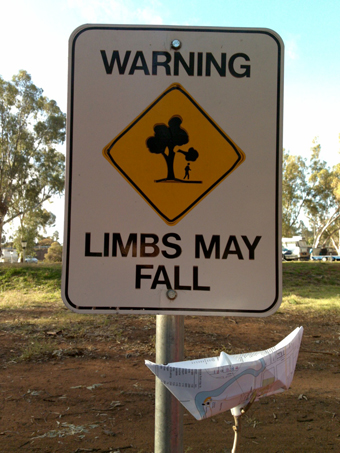
In Search of the Inland Sea, 2009, video still, Norie Neumark, Maria Miranda
courtesy of the artists
In Search of the Inland Sea, 2009, video still, Norie Neumark, Maria Miranda
Co-curator Norie Neumark contributes a work made with long-time collaborator Maria Miranda, In Search of the Inland Sea (2009). Neumark and Miranda’s work frequently uses offbeat humour to approach serious issues (see the review of their Talking about the Weather). In this instance the idea of the elusive inland Australian sea which captivated early settlers is explored through a series of vignettes. The spine of the work is a road trip that the pair undertook retracing the explorer Sturt’s original journey down the Murrumbidgee and Murray Rivers. However they have substituted a small paper boat for Sturt’s impractical whaling vessel. Mobile phone video footage of the journey is presented on a small screen but the road trip narrative is complicated by a soundtrack which draws on the spoken description of the plot of a Japanese horror film, about creatures emerging from murky waters to abduct people. On another screen we see hands folding pages from an old book on Sturt into small paper boats while the voice over, rather than reading from the book, describes the look of the pages and the typography, hinting at the absurdity of colonial formalities. A pile of paper boats also fills one corner of the space beneath the screens. On yet another small screen an endless strip of outback road is accompanied by slowed down voices describing an action scene from Mad Max illustrating 20th century interpretations of the Australian landscape. Through the accumulation of these quirky juxtapositions, we get a sense of the complexity of the fantasies and fears of a non-Indigenous relationship with the Australian outback.
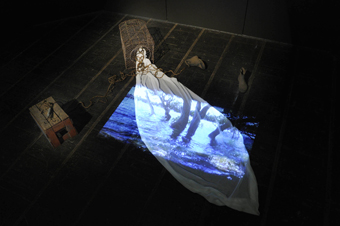
Cleanse, 2010, Megan Heyward
photo Adam Hollingworth
Cleanse, 2010, Megan Heyward
Several works used a more narrative approach to the thematic, recounting recollections of rivers and local waterways. The most stylish of these was Megan Heyward’s Cleanse (2010) which explores her childhood memories of the Parramatta River. Filmic-style video is down-projected onto a swathe of cloth issuing from a fishing trap. Scattered across the space are objects found around the river—old boots, fishing tackle, a wooden crate—which frame the viewing space. These memory fragments are intriguingly rich with a sense of the past, implying an innocence but also an ignorance in our past interaction with the ecosystem. Other works using documentary approaches, such as Shannon O’Neill and Jennifer Teo’s Waterfront Utopia (2010), Clement Girault and Victor Steffanson’s video component of Live Flows (2009), and to a lesser extent Ian Andrews’ Shifting Sands, are certainly accessible and informative if too illustrative for my taste, lacking complexity in the handling of their subjects.
While there was some similarity of approach, the standout works illustrated a range of stylistic and conceptual explorations on the thematic, and the venue choice added strong site-specific resonances to the exhibition. Perhaps more importantly Memory Flows introduced thought provoking and well-executed media art to a large general public.
Memory Flows, curators Norie Neumark, Deborah Turnbull, Sophia Kouyoumdjian; a project of Centre for Media Art Innovation, UTS, Sopa programming Tony Nesbitt; artists Ian Andrews, Chris Bowman, Chris Caines, Damian Castaldi, Sherre DeLys, Clement Girault, Jacqueline Gothe, Ian Gwilt, Megan Heyward, Nigel Helyer, Neil Jenkins, Solange Kershaw, Roger Mills, Maria Miranda, Norie Neumark, Shannon O’Neill, Greg Shapley, Victor Steffenson, Jes Tyrrell, Jen Teo; Newington Armory, Sydney, May 15-June 20; http://memoryflows.net
CMAI director Norie Neumark will be leaving UTS in July to take up a new position at La Trobe University.
RealTime issue #97 June-July 2010 pg. web
© Gail Priest; for permission to reproduce apply to realtime@realtimearts.net

l-r: Devi Fitria, Melissa Quek, Dinyah Dinyah Latuconsina (Cultural Program Assistant), Keith Gallasch, Giang Dang, Joelle Jacinto, Cat Ruka, Bilqis Hijjas, Pawit Mahasarinand
photo Phalla San
l-r: Devi Fitria, Melissa Quek, Dinyah Dinyah Latuconsina (Cultural Program Assistant), Keith Gallasch, Giang Dang, Joelle Jacinto, Cat Ruka, Bilqis Hijjas, Pawit Mahasarinand
THANKS TO AN INVITATION FROM FRANK WERNER, REGIONAL HEAD OF THE CULTURAL PROGRAM DEPARTMENT AT THE GOETHE INSTITUT INDONESIA, I WAS DELIGHTED TO ATTEND THE 10TH INDONESIAN DANCE FESTIVAL (TITLED “POWERING THE FUTURE”) IN JAKARTA TO RUN A REVIEW-WRITING WORKSHOP FOR THE INSITITUTE IN RESPONSE TO FOUR DAYS OF EXHILARATING DANCE FROM INDONESIA, TAIWAN, JAPAN, KOREA AND EUROPE.
Amidst the festival hubub, new cuisine experiences, nerve wracking city traffic and World Cup tensions (after all, our host was a proud and anxious Goethe Institut), the workshop team saw shows, discussed and wrote (late at night or early in the morning), read each other’s reviews and shared knowledge and opinions.
The workshop participants were a fascinating mix: some had professional dance and producing experience, some were already reviewing, running blogs or contributing to magazines and newspapers, others were starting out.
Cat Ruka from New Zealand is a dancer, performance artist and the editor of Yellingmouth, an Auckland-based dance review blog. Melissa Quek from Singapore is a choreographer, a teacher at LASALLE College of the Arts
and a freelance dance reviewer for The Business Times. Joelle Jacinto from the Philippines is a dancer and a freelance writer with many years of experience. She is editor-in-chief of Runthru, a bi-annual dance magazine and website. Bilqis Hijjas creates, performs, produces, teaches and writes about contemporary dance in Kuala Lumpur, Malaysia and runs a residency for choreographers at the private arts centre Rimbun Dahan. Devi Fitria is a Jakarta-based journalist who works for the Indonesian art magazine ARTI and an online history magazine, HISTORIA. San Phalla lives in Phnom Penh, holds degrees in Southeast Asian Studies and archaeology and works as a researcher for Khmer Arts, a Cambodian classical dance company that tours the world. Dang Giang, from Vietnam, is a writer and cultural and social activist.

Pawit Mahasarinand
photo Keith Gallasch
Pawit Mahasarinand
Parwit Mahasarinand, a theatre lecturer and dance reviewer since 2000 for The Nation English language newspaper in Bangkok, was a very welcome addition to the workshop after he’d delivered a keynote address (“If we write more—Observations on contemporary dance criticism in Asia”).
Dance scholar, archivist and writer Franz Anton Cramer (Paris/Berlin) delivered two talks, one on the ethics and aesthetics of criticism and the other an invaluable and subsequently hotly debated introduction to the works of Meg Stuart and Philipp Gehmacher who were performing Maybe Forever in the festival.
The aim of the workshop was to improve the capacity of reviewers to vividly evoke the works they experience for their readers. Good reviewing (whether or not it consciously includes social, political and economic perspectives and passes critical judgment) cannot work effectively without this skill. Openness, strong recall, rich vocabulary, a structured response, the careful delivery of judgment, these were the workshop focus.
I was pleased that all participants willingly and bravely committed themselves to a challenging task—to respond very quickly to new dance works while focusing on writing skills and being subjected to criticism. As you read the reviews posted here do keep in mind that they were written under pressure and with limited time for editing and polishing. Despite these demands there are fine examples of vivid and thoughtful writing to be found in the 23 reviews that came out of a mere four days of what appeared to be happy labour. It was particularly pleasing to see increased attention not just to movement details but also to music, sound, set design, lighting and the ways in which, in this era of hybridity, various forms mix and meld.
The festival provided challenges for all of us in the workshop. Many works drew on traditional dance, customs and beliefs, sometimes leaving us guessing as to specific meanings while fascinated with what we seen. It’s doubly difficult given that the works are themselves contemporary interpretations or re-workings of traditional forms. Sometimes one of our number had an answer, or we googled one, provisonally, knowing that a dance festival like this one can only serve as an introduction to unfamiliar forms. Inevitably we debated the advisability of reviewing works where we lacked cultural understanding—would we misrepresent what we saw or were we encouraging interest and a sense of inquiry?
Other issues discussed included the significance, or not, of English language dance reviewing in Asia, a shortage of good editing, and a certain reviewer caution about being judgmental—verbal opinions were often tougher than those that appeared in print, said a number of participants.
![l-r: Giang Dang, Phalla San, Joelle Jacinto [outside theatre]](https://www.realtime.org.au/wp-content/uploads/art/37/3701_gallasch_idf3.jpg)
l-r: Giang Dang, Phalla San, Joelle Jacinto [outside theatre]
photo Keith Gallasch
l-r: Giang Dang, Phalla San, Joelle Jacinto [outside theatre]
From the too real street fighting of contact Gonzo to the contemplative account of a relationship breakdown in Maybe Forever and on to a range of works that engage simultaneously with traditional Indonesian forms and contemporary ideas (about homosexuality, globalisation, identity, climate change), you’ll discover in our workshop reviews an Indonesian dance festival engaged directly with the role of dance as art, and as life.
It’s hoped that the workshop will further the bringing together of dance artists and writers in the region.
The initials of the workshop writers will link you to their reviews of the following works:
Kim Jae Duk Project, Darkness Poomba [South Korea]: PS, CR, MQ, PM
contact Gonzo [Japan]: CR, GD, PM, MQ
Gusmiati Suid, Seruan [Indonesia]: DF
Asry Mery Sidowat, Merah [Indonesia]: JJ, MQ, DF
Muslimin B Pranowo, The Young [Indonesia]: BH
Jecko Siompo, From Betamax to DVD [Indonesia]: PS, MQ, JJ
Eko Supriyanto, Home: Ungratifying Life [Indonesia]: JJ, MQ
Vincent Sekwati, Barena ‘Chiefs’ [Indonesia]: MQ
Shinta Maulita, GAYaku [Indonesia]: DF, MQ
Ajeng Soelaiman, Andara Firman, S]h]elf [Indonesia]: GD
Cross Over Dance Company, Middle [Taiwan]: BH
Meg Stuart, Philipp Gehmacher, Maybe Forever [Berlin/Vienna]: BH, CR, GD, JJ, PM
Joko Sudibyo, Cekrek [Indonesia]: MQ, DF
Closing Night Performance: JJ, MQ
Emerging Choreographers Program: MQ, DF
You can see all 23 reviews at 10th Indonesian Dance Festival: Goethe Institut Regional Critic Workshop
Goethe Institut Indonesia, Regional Dance Critic Workshop, June 14-18, held during the 10th Indonesian Dance Festival, “Powering the Future”, June 14-17
This article first appeared online July 12, 2010
RealTime issue #99 Oct-Nov 2010 pg. web
© Keith Gallasch; for permission to reproduce apply to realtime@realtimearts.net
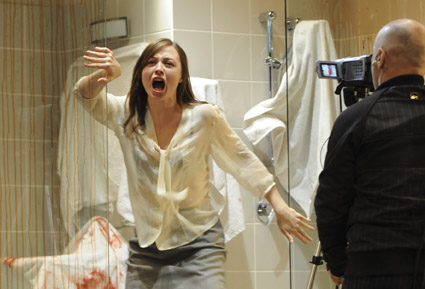
Robin McLeavy, Arky Michael, Measure for Measure, directed by Benedict Andrews
photo Heidrun Löhr
Robin McLeavy, Arky Michael, Measure for Measure, directed by Benedict Andrews
SHAKESPEARE’S MEASURE FOR MEASURE HAS LONG BEEN REGARDED AS A ‘PROBLEM PLAY.’ IT’S A CLASSICAL COMEDY IN MANY RESPECTS, FOCUSED ON LOVE AND EVERYDAY SEXUAL MORES, LOADED WITH HIDDEN IDENTITIES, SUBSTITUTIONS AND COMICAL MISCALCULATIONS AND IS RESOLVED WITH A WELTER OF MARRIAGES INDICATIVE OF SOCIAL RENEWAL. HOWEVER, THE PLAY’S TONE IS SURPRISINGLY DARK FOR A COMEDY, IF NOT BLACK, ALTHOUGH BENEDICT ANDREWS’ PRODUCTION FOR COMPANY B SOMETIMES APTLY PAINTS IT SO. WHILE THE THREAT OF DEATH IS NOT UNCOMMON IN COMEDY, IT’S USUALLY TREATED LIGHTLY, BUT HERE SHAKESPEARE MAKES ITS LIKELIHOOD PALPABLE. THE SUFFERING OF THE PRINCIPAL CHARACTERS IS PAINFULLY ACUTE AS THE LAW TURNS UNJUST AND A CRUEL INEVITABILITY TAKES OVER—TRAGEDY IS IMMINENT.
Measure for Measure (1604) is snared by the dark side of politics. That’s not unusual for a comedy of the first decade of 17th century London, but here state power is enacted with such severity and in such an un-comedic vein that the play teeters uncomfortably between genres. This is especially so at the end when Shakespeare attempts to balance the return of justice with the demands of comic resolution. This complication is amplified in the final act by a deus ex machina who is the principal cause of the near tragedy. Consequently, while it makes fine fodder for literary debate, Measure for Measure is not frequently produced and the directorial challenge to achieve a unity of vision is formidable.
However, while the ending of the play remains forever problematic, the relationship between serious drama and comedy is, for the most part, dynamic. Disturbed by a rise in sexual licentiousness among his citizens, the Duke of Vienna (Robert Menzies) absents himself, leaving the city in the hands of a trusted deputy, the morally respectable Angelo (Damon Gameau) who immediately commences a series of brutal prosecutions at all levels of society. Prostitutes, bawds, officers of the law, citizens and politicians are suddenly thrust together. Measure for Measure is kin to the satirical Jacobean city comedies of the 1600s—urban, licentious and laced with droll seriousness, as when the bawd Pompey (Arky Michael), forced to become an executioner’s assistant, decries the ‘mystique’ of haughty executioners. The Provost (Steve Rodgers) concurs in a retort to the offended executioner, “Go to, sir, you weigh equally [with bawds]: a feather will turn the scale.”
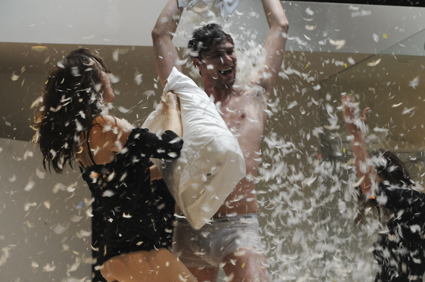
Robin McLeavy,Toby Schmitz, Maeve Dermody, Measure for Measure
photo Heidrun Löhr
Robin McLeavy,Toby Schmitz, Maeve Dermody, Measure for Measure
Comedy and drama are at one in the play’s struggle to balance personal freedom and the demands of law, not least when power is being abused. Angelo decides to execute Claudio (Chris Ryan) who has impregnated his fiancée, Julietta (Maeve Dermody). Angelo then demands the sexual favours of Claudio’s sister, Isabella (Robin McLeavy), a novice nun, in return for her brother’s life, a bargain he has no intention of honouring. Benedict Andrews keeps the comedy rude and raw, even grossing it up with an early group sex and pillow fight scene (the world awash with feathers for the remainder of the first half of the play) and later with Lucio (Toby Schmitz) engaging furiously in frottage and penetration with a tiger lily. It’s as if to say, yes, the city is depraved, but which is the greater evil—general licentiousness or the abuse of power?
The sense of a coherent world is made more concrete by having all of the action occur within one intensively surveilled room. As it revolves it becomes other spaces (nunnery, cell, office) but its commonality is produced by the space reducing cameras hand-wielded or secreted in ceilings by the mass media or the state and the Duke’s personal surveillance in his guise as a man of the church manipulating the action. The result is a closed, dangerous world where everything is bared and controllable.
The revolving room is framed either side by large screens which provide close-ups of the characters and medium shots of character groupings, offering alternative layers of comment and emotional intensity. The sense of portraiture is particularly strong (the printed program reproduces Giorgio Agamben’s essay “The Face”). Flickering into focus, still, listening faces appear like paintings—Isabella as if rendered by Vermeer. At other times the images are hard—the over-lit pornography of interrogation and intrusion. Actors take turns at operating cameras, standing mid-action, ignored by the characters they’re filming and eventually by the audience, so familiar is the idiom, its power neglected at our peril. We peer at faces, looking as we do in portraiture for some kind of truth or essence and with increasing uncertainty.
The interplay of live action and its immediate screening is engrossing, even in a small theatre where you often have to choose where to direct your attention (especially if you’re sitting close to the stage—not an ideal position). Some moments become almost entirely cinematic, one of the most affecting being when Isabella tells her doomed brother that she cannot rescue him from death. In low blue light the stage is almost dark, brother and sister initially either side of a glass wall, her face reflected over his, amplifying the sense of kinship at the same time as a terrible moral divide. Ryan and McLeavy, advantaged as well by head microphones, play the scene with a low key, nuanced intensity. Sean Bacon dexterously live edits the camerawork with an air of improvisation while simultaneously, assured artistry is evident in every carefully framed image right down to the panning shots across fallen feathers as scenes are bridged.
As usual with Benedict Andrews there’s a bracing thoroughness in the way he takes a conceit, gives it body and weaves it through his productions, just as Shakespeare does with metaphor and its embodiment. The video shooting is seamlessly integrated into the action—Isabella huddles in a cupboard, aiming a camera at herself; the arrested Claudio spits into the lens; the death row prisoner, Barnadine (Colin Moody), face-painted with blood and faeces after trashing the hotel holding room he’s been locked in, leers into the surveillance camera—he knows he has an audience. We watch characters going to the toilet, being subjected to urine tests and genetic swabbing as a matter of course. When the Duke steps out of the surveillance frame it’s a shock—he needs greater distance from his world than a disguise can allow. It’s also preparation for the very final moment of the production: it had the audience cheering and, in a way, answered at least one ‘problem’ inherent in the play—but you need to see that for yourself.
McLeavy is excellent as Isabella, making the most of the young woman’s alternations between hesitation and determination, above all marking her surprise, right to the end, at the world in which she has found herself. Her sudden, angry insight into the wrong done Claudio by Angelo is powered by logic—no wonder he is taken by her. Yet, she cannot fully understand her brother’s anguish at her refusal to surrender to Angelo. (Another of the play’s ‘problems’ is that although she aids the outing of her nemesis, it is eagerly at the ‘expense’ of another woman going to Angelo’s bed in her stead.) Frank Whitten makes a fine Escalus, an older statesman trapped between Angelo’s dictatorial actions and his own sense of fair play. Arky Michael is a sympathetic, funny Pompey and the sense of desperation and panic among the bawds is convincing as the law is forcefully enacted.
I was less certain about Damon Gameau as Angelo. Except for the moment Angelo speaks with sheer surprise at his attraction to Isabella (running a hand over an erection), the portrayal seemed oddly neutral—as if Angelo is all enigma, a man not to be gauged except by reputation. Where was the personality, evidence of the will that could frighten the populace and compromise fair men like Escalus? Robert Menzies as the Duke was at his best in the long final scene, fiery, fast, in control, cruelly if logically playing out a game to trap Angelo. His anxious, machinating and sometimes shocked friar was less convincing—could there have been more to the Duke and his friar self than the stolid interiority that emerges from time to time in Menzies’ performances, as in his Brutus for Andrews’ Julius Caesar for the Sydney Theatre Company.
Toby Schmitz’s Lucio is a highlight—all at once an exemplar of the city’s debauchery, a loyal friend to Claudio (it’s Lucio who persuades Isabella to act) and an otherwise obtuse judge of personalities and situations. Schmitz creates a tunnel vision personality, cocky, rude and stylishly contemporary, while making remarkably easy sense of Shakespeare’s language.
Although not entirely convinced by the accounts of the Duke and Angelo, I nonetheless found Andrews’ production to have a marvellous cogency in its sense of a self-contained world, amoral but soon painfully intent on achieving a balance between law and justice. The Duke’s city has real problems which are presented with apt rawness, visually and loudly. At other moments, Measure for Measure is played and intimately projected with the requisite delicacy, if always underpinned with urgency. Andrews and his collaborators make Measure for Measure a play for our times, bringing to the stage the invasive cameras of news media and surveillance as the latest tools of power, cruelly distorting prisms that nonetheless, and quite ironically, allow us here to see further than we usually might.
Company B Belvoir, Measure for Measure, writer William Shakespeare, director Benedict Andrews, designer Ralph Myers, costumes Dale Ferguson, lighting Nick Schlieper, composer, sound Stefan Gregory, video design, operator Sean Bacon; Belvoir Street Theatre, Sydney, June 9-July 25
This article first appeared online July 12
RealTime issue #98 Aug-Sept 2010 pg. web
© Keith Gallasch; for permission to reproduce apply to realtime@realtimearts.net
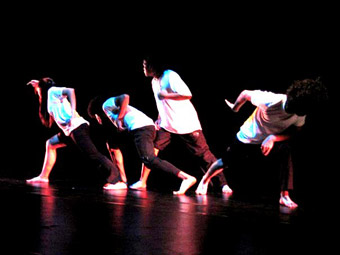
From Betamax to DVD
photo Phalla San
From Betamax to DVD
ONE HAND, BENT SEVERELY AT THE WRIST, PRESSES RIGIDLY AGAINST THE CHEST, WHILE THE OTHER IS LOWERED BUT ALSO ANGULARLY BENT AT EVERY JOINT. TORSOS ARE THRUST FORWARD, AND ALL THE WEIGHT OF EACH BODY IS DRIVEN INTO THE LUNGING FRONT LEG, WITH THE OTHER ALSO BENT AND SLIGHTLY OUTSTRETCHED BEHIND. THE HEAD IS TILTED TO THE SIDE, SEEMING TO LOOK AT THE AUDIENCE SIDEWAYS, AS IF WARILY ASSESSING HOW THEY WILL BE ASSESSED IN TURN. FROM THIS STANCE, THE SIX DANCERS IN JECKO SIOMPO’S FROM BETAMAX TO DVD PERFORM FAST, VERY PRECISE, UNCONVENTIONAL MOVEMENTS, STEPPING IN AND OUT OF COMPLICATED PATTERNS WITHIN INDIVIDUAL FLOOR SPACES, EACH TWISTING A KNEE SIDE TO SIDE AS THE FOOT IS LODGED FIRMLY ON THE GROUND. THEY STOP AS ABRUPTLY AS THEY STARTED, THEN BEGIN AGAIN, EACH SEQUENCE DICTATED, OR EVEN ACTIVATED BY, A VOCAL SIGNAL FROM ONE OF THE DANCERS, A YELP OR BARK OR A SHORT, SHRILL CRY.
Every now and then, one or more of the dancers breaks out of their staggered line with an outburst of emotion, a comment to a fellow dancer, another version of the same fast angularity or a completely different, exaggeratedly sinuous movement. But they all return to the original stance, sometimes of their own volition, sometimes to a reprimanding hiss from dancer and choreographer Jecko Siompo. From Betamax to DVD was premiered in 2009 and shot Siompo to stardom not only as a ground-breaking local choreographer, but also as one of “20 Young People in Indonesia Who Have Made History.”
Siompo was the first choreographer featured in the final program of the 10th Indonesian Dance Festival. The bill also included works by Eko Supriyanto and Vincent Sekwati Koko Mantsoe. The trio was a particularly interesting closing line-up: two very different works from major Indonesian choreographers and an invited dancer/choreographer whose work is also vastly different yet exhibits values evident in the preceding pieces. None of these are show-stopping, bravura numbers, which would be the case in a festival in the Philippines, where I’m from, which is why I think this line-up says much about Indonesian culture.
Siompo and Supriyanto’s works, although not similar at all, seem to represent what Indonesian contemporary dance is currently all about. While one is a stream of fast-paced, repetitive movement and the other often has barely any movement at all, they both appear to be manifestations of ideals evident in the previous day’s showcase of emerging choreographers. Indonesian audiences, I have found, appreciate the slow-moving contemporary pieces that make you think, and they are, I’ve been told, rather fond of discussing a work’s meaning after the curtain goes down. The rousing applause that followed all three final night works suggested this might be the case.
Eko Supriyanto’s Home: Ungratifying Life starts with the choreographer crossing the stage with an almost agonizing slowness. Halfway across, he adds a small crouch before the next step, a small lift of an extended leg before the next, a small twist of the body, and so on. All this time, he is enveloped in silence—or rather the annoying clicking of too many audience cameras in a frenzy to capture his every move. But he rest of the piece is “performed” to high-pitched singing and a deafening, incessant whine from the sound score, as different characters approach a wooden frame hanging front and centre—an old, weathered angel, two near-naked men, a man in a pink tutu and a girl walking a dog. They look out from behind the frame as if from a window, peering at the audience as we inescapably stare back. The man in the tutu, revealed to be the source of the relentless singing, pauses only to rudely ask, “What are you looking at?” From a choreographer who has danced for Madonna and appeared in films, Supriyanto is obviously questioning such scrutiny and what all the hoopla is about. What I find compelling is that the audience gets this.
It appears that younger dance practitioners in Indonesia also get what Supriyanto and Siompo are saying and are applying these ideals to their work. The Emerging Choreographers showcase displayed these aspirations. For example, I could see an impulse from the younger choreographers to pepper their works with Javanese poses and gestures, to the same degree that Siompo has drawn from his native Papuan dance forms and reconstructed them to create his own movement. There is also a need to provoke, as Supriyanto does, even if the challenges posted by the younger choreographers are not yet as mature—or as taxing for their audience.
But there are promising ideas, especially from Santi Pratiwi, whose Retorika Kerinduan adequately captures the disquiet of a village whose former inhabitants have all moved to the city for supposedly better opportunities, as well as Joko Sudibyo, whose Cekrek is an engrossing peek into the kind of drama that only goes on inside one’s family home. The movements in Retorika Kerinduan cleverly delineate the differences between village and city—getting away from the city is depicted by running around the ‘village’ at top speed while the ‘city’ captures the villagers with lethargy. Given more time for development, Retorika Kerinduan could be even more striking. In Cekrek, I particularly liked the sharp contrast between the four young boys, who all moved with fluid vitality, and the crying woman whose few moments of dancing were caricatured for comic effect. Perhaps I would have better appreciated the work if I’d understood what she was saying as blithered away to the audience in a local language. Nevertheless, the images had great strength.
In the case of From Betamax to DVD, which I first saw last year, the festival also provided the opportunity to see a work that has been further developed. I detected an increase in the tension between technology and tradition in the updated soundscape of spliced engine noise (cars, planes, machines) and electronics (network buzz, connecting modems) and the stronger responses of the dancers to the score. Perhaps Siompo was pushing this tension more to the surface, or I was more aware of it on second viewing.
Other changes were less successful, with the dancers showing more personality and given more opportunities to dominate Siompo in his role as the outsider. Last year, he was in control—the performers moving in unison and in staggered groups, but always returning to the line at Siompo’s barking command. In this “improved” version it doesn’t seem that the dancers appreciate his presence; one girl even breaks formation to shriekingly chastise him. Perhaps the dancers, some of whom are making choreographic ventures themselves, are becoming more confident, finding their own voices—their yelps and screeches here growing louder and more consistent, symbolic evidence that the Indonesian dance scene is expanding and strengthening.
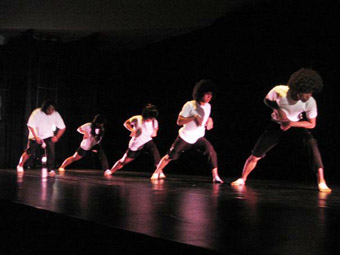
From Betamax to DVD
photo Phalla San
From Betamax to DVD
FROZEN IN TIME, FIVE DANCERS, IN PLAIN WHITE T-SHIRTS AND BLACK TRACK PANTS STAND IN A NARROW LANE OF LIGHT IN JECKO SIOMPO’S FROM BETAMAX TO DVD. A DIZZYING ELECTRONIC SOUND-SCORE REVERBERATES AROUND THEM. A QUICK TWITCH, HOP AND HIT FROM SITI AJENG SOLAEMEN AT ONE END GALVANIZES ANDARA FIRMAN MOEIS AND THEN JECKO SIOMPO (ALSO THE CHOREOGRAPHER) INTO MOVEMENT AT THE OTHER. SIOMPO JERKS OUT OF LINE AND MOEIS FOLLOWS ONLY TO BE HERDED BACK INTO PLACE.
With a loud yelp the dancers break into a litany of isolated movements: arm tuck, leg stamp, head jerk. At one count per movement, they dance at a bracing if predictable speed. The dynamic energy, vigorous dancing and clarity of movement in each shape is virtuosic and exciting, at first. But it continues in this vein for the rest of the piece, quickly shifting shapes at a fast and even rhythm, developing in a high impact but monotonous line—there is no climax, only abrupt stops and starts. It’s a long run-on sentence, barely punctuated by stillness and often underlined by yips and barks.
Yes, the dancers change formation and move in and out of the lane of light, but it’s basically different combinations of the same thing. However Siompo’s tackling a big topic: “the advancement of technology is a message from tradition” (program note), which is something you probably wouldn’t have understood if not for this one line synopsis. If the advance of technology is the move from one system to another, Siompo’s movements similarly change little to fit his theme. His movement language is a pronounced mixture of Papuan dance and hip hop, with the shapes inspired by Papuan animals (mainly the small kangaroo) and the rhythm consistently fast.
The driving force of Siompo’s movement dynamics and his use of universally recognizable sounds are part of his appeal to a global audience. These concrete sounds are also a major vehicle of communication in his work. The beep of electronics, the roar of traffic and the performers’ voices form a medley of the organic and synthetic. In this case the persistent switching of sounds is closely reflected in the changing dance formations, but the consistency of movement seems to indicate that although the world is constantly changing it remains essentially the same.
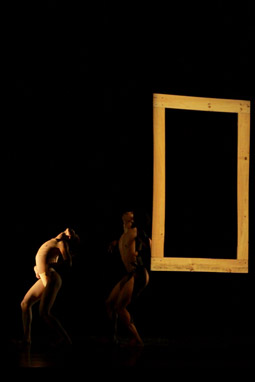
Home: Ungratifying Life
photo Phalla San
Home: Ungratifying Life
In contrast Eko Supriyanto’s Home: Ungratifying Life comprises startling images. Most of the music may be sung in traditional Javanese, a language that even in Indonesia few understand, but is overlaid with a high pitched, painful, piercing whine. The choreographer has cleverly blended east and west in his symbolism. Wearing a batik shirt and clunky boots, a long pony tail trailing down his back, Supriyanto walks very slowly across the forestage in a narrow beam of light. When he reaches the centre, he’s directly in front of a large suspended rectangular wooden frame. His arms move meditatively, fingers briefly flickering before his face. Then with his eyes looking straight through the frame, he backs towards the edge of the stage and falls into the dark auditorium.
In the blackness two white figures slowly appear to take shape, but they are one—a man in black with a pair of large, white feathered wings, perhaps a depiction of the angel of death, slowly walking to the frame. Here he stands for along time, his few moves a gradually morphing picture as he looks out into the audience—or is he framing himself? He retreats and two young men, wearing only jock-straps, bound into the light. Long arms flaying the air, they energise the previously quiet stage. Even in sculptural moments behind the frame and in rectangles of light their sinuous forms appear primal and strong, while their continual gazing upwards or long reaches down to the floor suggest an unseen spiritual realm.
The men are replaced by a woman walking quietly with her dog, displaying the strong bond between human and animal. They are accompanied by a man who, with his short cropped hair, thin moustache and gaunt body dressed in a neon orange tutu with frilly straps, makes a curious picture that is initially surprising but soon taken for granted. He sings but stops abruptly to provoke the audience, shouting through the frame “What are you looking at?” After which he calmly resumes his song and moves away into the darkness, the dog’s eyes following him, while the girl stands staring out of the frame into the distance, inexplicably serene. The dog seated by her side, without artifice, a symbol of domestication, is perhaps intended to remind us of our relationship with nature.
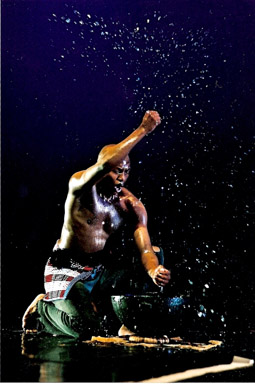
Vincent Sekwati Koko Mantsoe, Barena “Chiefs”
South African Vincent Sekwati Koko Matsoe’s Barena ‘Chiefs’ asks if power comes from the possession of symbols, like his ragged cape and stick, or if it’s inherent. Judging from the immense dynamism that he holds in check but releases at will it’s inherent in his case. His Afro-fusion (African and contemporary dance) style is emotionally expressive and physically demanding. Matsoe talks as he moves and the sounds of animals hooting and howling is underpinned by a strong beat that drowns out his voice, but the power in his furrowed brows and wide glaring eyes is clear. Later he droops as if defeated and drained, only to then grin widely as his feet and head move at a blur. Emotionally exhausted with him, I welcome Eric Satie’s soaring refrains that float over the stage, but instead of dancing to the melody, Matsoe confounds expectations by continuing with his own energetically rhythmic phrases. By ignoring the change in music he has kept the power and control firmly within his own body.
These three choreographers delivered humanistic and existential messages, each in an individualistic and surprisingly self-conscious manner. Each appears as the central figure in their own works, their bodies enabling the narrative. Siompo is the odd figure in From Beta Max to DVD, facing away from the rest of the group, a lag to his movements pulling him out of synch, exhibiting a rare awareness of the difference between himself and his younger counterparts. Supriyanto’s is the first body to peer through the frame at the pictures that slowly take shape on stage in his Home: Ungratifying life. His leap into the blackened auditorium aligns him with the audience and invites us to see through his eyes, which is also the function of his choreography. The crux of Beran ‘Chiefs’ is encapsulated in Matsoe’s on-stage figure, his body containing both symbolic and inherent power, his physical journey the vehicle with which the audience navigates the work.
In this closing performance for the 10th Indonesian Dance Festival—with its “powering the future” motto—these mature choreographers can be seen as representative of the ‘now’ of contemporary dance, examples for future generations of Indonesian choreographers to follow.
Excluding Boi Sakti, who last year announced his intention to stop choreographing, Siompo and Supriyanto are currently Indonesia’s biggest contemporary dance exports (the titles of both their works were in English and not culturally specific). If the selection of emerging choreographers for the festival is anything to judge by, young dancers and choreographers are getting the message loud and clear, showing marked tendencies towards high-art symbolism delivered at an elaborately slow pace or making an impact with a plethora of movement. But that’s to be understood, since learning often starts with mimicry. The real question is should there be more of it?

From Betamax to DVD
photo Phalla San
From Betamax to DVD
TO THE SOUND OF TRADITIONAL MUSIC AND IN GLOOMY LIGHT, THE FIVE YOUNG DANCERS—THREE WOMEN AND TWO MEN—OF THE JECKOSDANCE TROUPE LINE UP LOOKING TOWARDS THEIR LEADER, THE CHOREOGRAPHER JECKO KURNIAWAN SIOMPO PUI. THE SINGING CUTS OUT, REPLACED BY THE SOUND OF A STREAM. A GIRL AT THE BACK OF THE LINE MOVES FORWARD A FEW STEPS AND SWINGS HER RIGHT HAND. HER ENERGY SEEMS TO SWAY THE GIRL AT THE FRONT OF THE LINE CAUSING JECKO TO SWING BACK AND FORTH LIKE A ROBOT. HE SHOWS OFF HIS DANCE TECHNIQUE TO HIS TEAM, BUT THEY DON’T SEEM TO APPRECIATE IT. ONE CRIES OUT AND THEY MAKE THEIR OWN DANCE INSTEAD.
From Betamax to DVD is a multi-dance work that includes a synthesis of breakdance, acrobatic, robotic, traditional Papuan dance and animal movements—mimicking apes (bodies held low) and kangaroos (both hands held to chests), pushing and pulling each other to produce comic moments. Repeated, robotic action, also found in breakdancing, is common while other moves look athletic, as if the performers are preparing to run—a body bent forward, one leg stepped back, the other forward, bent at the knee,
The performers danced in line, broke from it and criss-crossed. But Jecko seemed to be trying to stay free of his colleagues. They tugged at his t-shirt, wanting him to join in, but he repeatedly pushed them away as if to resist modernity and its rapidly changing technology, to stay with Papuan tradition. Nevertheless he sometimes joined them, dancing in line, because there are some things you cannot avoid in a globalised world.
Dance movements switched fast to changes in light and sound, alternating between loud and soft: a mix of flowing water, car horns, helicopters, jet planes, computer sounds, electronic blips, waltz music, club music…This rush symbolized a rapidly changing culture where no one pays attention.
At the end, the dancers lined up again to face the audience, posing the same question: will Jecko accept modernization and leave tradition behind?
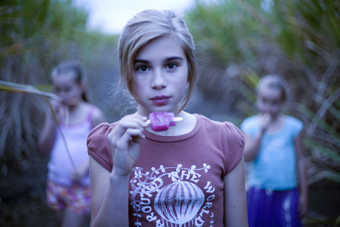
Lily Bell-Tindley, Lou
THERE’S BEEN MUCH CRITICISM OF THE AUSTRALIAN FILM INDUSTRY IN THE PAST FEW YEARS FOR DEALING WITH DEPRESSING ISSUES, PRODUCING KITCHEN-SINK DRAMAS AND BLEAK FAMILY SCENARIOS THAT (APPARENTLY) PEOPLE ARE RELUCTANT TO WATCH. WHILE I DISAGREE WITH THIS ASSESSMENT (I AM DRAWN MORE OFTEN TO THE DARK SIDE THAN THE LIGHT, AND THINK FILMS LIKE BEAUTIFUL KATE OUTRATE I LOVE YOU TOO), IT SEEMS THE FUNDING BODIES ARE MOVING TO ADDRESS IT, SO WHAT WE HAVE INSTEAD SEEMS TO BE A WAVE OF COMING-OF-AGE TALES SET IN RURAL TOWNS, CONTEMPORARY BUT BATHED IN THE GOLDEN LIGHT OF NOSTALGIA, WHERE FAMILIES LIVE IN WEATHERBOARDS WITH VERANDAHS AND CHILDREN YEARN FOR MISSING PARENTS.
I’ve recently seen The Boys are Back (Scott Hicks), The Tree (Julie Bertucelli) and now Lou, written and directed by Belinda Chayko. It seems a shame for the local industry that these themes are so obvious because, while all three films stand alone as decent offerings, seeing them bunched up means there’s a feeling of deja-vu—hey, haven’t I visited this place before?
Belinda Chayko is a Brisbane writer/director who, like Shirley Barrett, has taken 10 years to release her latest feature, after making City Loop in 2000. In the meantime she has worked on TV projects and won an AWGIE for writing Saved (Tony Ayres, 2009), about a young Iranian refugee held in detention and his advocate.
Set in cane country, the film focuses on Lou (Lily Bell-Tindley) who lives with her young single mother Rhia (Emily Barclay) and two sisters. Like Charlotte Gainsbourg’s Dawn in The Tree, Rhia is struggling to keep it together after the father leaves (in this case he just nicks off) and pines for her new lover, as the girls hover and judge. Over the Christmas holidays their lives are disrupted when Rhia’s father-in-law Doyle (John Hurt) is suddenly dumped on the household (Rhia finds she can earn money by letting him stay).
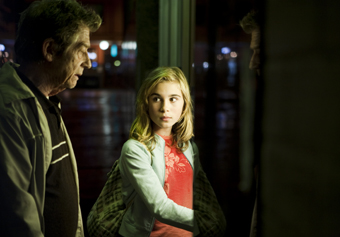
John Hurt, Lily Bell-Tindley, Lou
It’s quite a coup to have Hurt (one of the most outstanding actors working today); his scenes with Bell-Tindley elevate and enliven the story. Bell-Tindley's like a young Abbie Cornish (strong and understated, there’s no cute kid antics here) and she easily holds her own with Hurt. Together—Doyle has Alzheimer’s and sees Lou as his departed wife, Annie—they form a kind of old-fashioned romantic bond that’s subtly directed by Chayko. Barclay, as always, is both tough and fragile. There’s an ordinariness about her that I respond to but she has that ability, like Toni Collette, to transform into anyone.
What I found confusing about the film (and perhaps this is the nature of the disease itself) is the inconsistency in Doyle’s character. He is introduced at the family dinner table as belligerent and angry, swearing profusely and unpredictable. Someone who won’t have a shower, who’s “starting to stink!” At a dinner that Rhia has carefully cooked for her new man, Doyle spits the food over the table: “This is the most disgusting thing I’ve ever eaten!” But we never see him like this again. As his relationship with Lou develops he becomes almost a Hallmark card of sweet good-naturedness, someone that she can trust, a regular grandfather who can take the girls to the beach on the bus (albeit with the occasional bout of jealousy as Lou/Annie becomes interested in a local boy who delivers the paper).
Then suddenly, at the climax of the film, only then, Doyle starts to speak in the spin cycle so familiar to anyone who’s lived with dementia. He begins to repeat phrases—”are we going home by bus?”— until Lou realises her dream of escape has evaporated. It feels like the disease is being worked in around the plot, making false moves. The film is also let down by a few clichéd scenes that seem out of character. When Rhia discovers Lou wearing make-up, she slaps her: “Get that lipstick off your face, you look like a skank.” I’ve encountered this scene in so many films but the extremity of the reaction in this case doesn’t ring true. A number of other scenarios might have worked better. It’s about pausing with the writing and taking a different tack from the predictable one. Also black-and-white is Doyle’s case manager Mrs Marchetti (Daniella Farinacci), an unsympathetic character treating the family with disdain. Surely not all bureaucrats are like this. God help us if they are.
Shot in Murwillumbah, the film looks gorgeous (cinematography by Hugh Miller, who also shot David Caesar’s Prime Mover), as this genre tends to, with the glowing night-sky of burning canefields, the retro interiors, the sensuous dancing of a young girl in a red dress wrapped in golden light. The mood and the rhythm are languorous, conjuring a hot summer holiday, where you drift from one day to the next. It’s a delicate film and I can imagine it will do well on the international film festival circuit. People were raving about it as we came out of the cinema. But I’m looking forward to a new wave of Australian films. I want to be challenged and shocked. I want to be thinking, “God, I’ve never seen anything like this.”
Lou, writer, director, producer Belinda Chayko, producers Tony Ayres, Helen Bowden, Michael McMahon, cinematographer Hugh Miller, editor Denise Haratzis, production designer Pete Baxter. Lou is in limited release around Australia.
RealTime issue #97 June-July 2010 pg. web
© Kirsten Krauth; for permission to reproduce apply to realtime@realtimearts.net

Maybe Forever, Philipp Gehmacher, Niko Hafkenscheid
photo Eva Wordinger
Maybe Forever, Philipp Gehmacher, Niko Hafkenscheid
A COUPLE, TRYING TO SLEEP THROUGH THE EARLY MORNING, LANGUIDLY SEEK THAT PERFECT POSITION BUT FIND THEMSELVES SUBCONSCIOUSLY REACHING FOR AND GRABBING ONE ANOTHER, AND NOT-SO-SUBCONSCIOUSLY PUSHING EACH OTHER AWAY, OR JUST PRETENDING NOT TO RESPOND. PRETENDING TO SLEEP. PRETENDING THAT EVERYTHING IS ALRIGHT.
In Meg Stuart and Philipp Gehmacher’s Maybe Forever, the pair then sit with legs outstretched and backs to the audience, leaning to the side at the same angle, plagued by a weight that neither can ignore. The performance space is hazily semi-lit, reminding me of the way light creeps into your bedroom at dawn. There is little stylization in the way the couple suddenly grab each other and spread against each other full length only to discreetly remove themselves from contact to find another spot on the floor; but this push-and-pull feels like a dance.
The basic movement in Maybe Forever is built around a soft hunching of the shoulders, drawing the arms up and outward, or crossing over in front of the body, in a subtly awkward manner. Both Stuart and Gehmacher do this, sometimes together, sometimes by themselves, but regularly throughout the 80 minutes of the work. Audiences familiar with Gehmacher’s work will recognize this as his preferred style. I don’t know his purpose for such movement, but it feels very apt for Maybe Forever.
The movement I’ve described is first seen in the fourth segment of the work, when Gehmacher re-enters the stage, if hinted at by Stuart in the third segment. Right after the early morning ‘pas de deux,’ guitarist Niko Hafkenscheid croons a song to us with “maybe forever…” in the lyrics. Stuart enters, wearing a skirt and blouse under a thick leather jacket, faces the audience and speaks as if to a former lover: “Remember when I said I wish you were here? I take it back.”
She mentions many things she would rather take back from her relationship, and quite a few things that she decided she doesn’t want to take back after all. As she speaks, she makes one or two brisk movements with her arms to punctuate or even halt her sentences, echoing the work’s movement motif, if not always obviously. Each time she moves her arms, her jacket squeaks, suggesting that in these confessions Stuart is largely uncomfortable, just trying to give herself more room to breathe.

Maybe Forever, Meg Stuart, Philipp Gehmacher
photo Chris van der Burght
Maybe Forever, Meg Stuart, Philipp Gehmacher
As soon as she is done, Gehmacher enters, carrying another microphone stand, but instead of speaking, he abandons it for centrestage where he performs a solo, hunching his shoulders to direct the movement of his arms which rise and fall and cross, both limp and stiff, in front of his torso.
He joins Stuart, who is stretched out on an elevated platform on the left side of the stage and tries to lie with her. He gets up quickly, turns away and then returns. She moves away, turns back to give him a full embrace, falls away again. And so they continue their earlier duet more lucidly, with the push-and-pull more pronounced—and we finally see that this signifies an inability to embrace.
Later there are more serious attempts to embrace, more effort to make things work, but also more despair, and a stronger sense of sadness. Stuart walks offstage, away from Gehrmacher more than once. He ignores this the first time, follows her on the second instance, he does not go far enough, choosing to wallow in self pity, perhaps, by a concrete wall, shoulders hunched, rather than running to reclaim her.
Stuart returns, as if to give Gehmacher another chance, performing a solo as he stands alone in a far corner. By now, I feel quite agitated by this continuing dance of frustration, as if experiencing it myself. I find this quite brilliant; it’s not spectacular but it is definitive. I have to admit that all this time I am waiting for a happy ending, that I want the “forever” to be the inevitable, instead of merely possibile. But even after the pair find each other in a successfully complete and tight embrace, he then fails to register where she goes next, never mind that she is constantly looking back to him, beckoning.
In few words and little movement, a relationship and everything wrong with it has been transformed from private memory to shared experience. It is as if the audience has been on this journey with the dancer-choreographers, felt the same hope and frustration, the same love and loss of love. At the end, Gehmacher finally takes the microphone to haltingly tell us that he is “ready…now…to…” Obviously he is not ready after all, as he looks at Stuart—sitting calmly to the side and now in a bright orange dress—probably waiting for her to finish the sentence for him. But she doesn’t. She just looks back at him, with none of the previous sadness or frustration, not giving him another chance this time. I was not surprised at the eruption of applause as the lights went out.

Maybe Forever, Meg Stuart, Philipp Gehmacher
photo Chris van der Burght
Maybe Forever, Meg Stuart, Philipp Gehmacher
“….IT COULD BE HEAVEN/ BUT IF IT’S HELL THEN YOU CAN WATCH ME BURN” (OZZY OSBOURNE, “CENTRE OF ETERNITY). MAYBE FOREVER EXPLORES A FAILED LOVE, THE SLOW BURN OF A RELATIONSHIP YOU KNOW YOU SHOULD END BUT JUST CAN’T BRING YOURSELF TO. OVER 80 MINUTES, THE WORK IS LONG, SLOW PACED AND OCCASIONALLY AS CUMBERSOME AS THE CRUMBLING RELATIONSHIP IT IS ABOUT.
Choreographed and performed by Meg Stuart and Philipp Gehmacher, the work starts in the dark, with a brooding, evocative soundscape of electronic humming and clicking. After a long while, as low, flickering light grows unnoticed, two indistinct figures are glimpsed, reclining, sleepily shifting, and then touching and pulling at each other. The dark makes reading individual moves and contact more an act of imagination than of sight. As dawn arrives, we are lured inside a crumbling love story.
Suddenly the light is bright, revealing a small structure on the left, half bed half podium, giving the space the feel of a living room-cum-club. Curtains flank a large photographic indtallation at the back, depicting a fern and two dandelions, their luminous fuzz suggesting impermanence.
Meg Stuart launches into a repetitive recital of bittersweet and melancholic thoughts about the affair. “Remember when I said I couldn’t live without you?” she asks. “I take it back.” She takes back statement after statement, once manifestations of affection and passion. Her leather jacket creakes discontently with each of her movements and, gradually, words are overtaken by arm gestures which grow more and more abstract. Throughout Maybe Forever, arm movements and gesture convey much of the communcation between the two.
Philipp Gehmacher has a nerdy manner, awkwardly stumbling through a man-boy haze. He is stiff, speechless until the very end, unable to articulate his emotions. There are moving moments, for example when he stands at the very front edge of the stage, holding his arms high above his head as if waiting to be lifted up, his face bathed in a happy light of distant memories.

Maybe Forever, Philipp Gehmacher, Niko Hafkenscheid
photo Eva Wordinger
Maybe Forever, Philipp Gehmacher, Niko Hafkenscheid
The third person in the mix, singer-songwriter Niko Hafkenscheid accompanies the lovers on their journey, playing beguiling indie pop melodies on electric guitar, singing softly with a warm voice and modest manner. He seems to be the only unwounded soul in the drama, and as he suddenly speaks directly to the audience it becomes apparent that his melancholy music is never just for these lovers; their romance can’t even claim its own music.
There are moments of peace and harmony, Gehmacher sitting upright on the floor, Stuart lying down on her side, her head on his lap. Motionlessly, they listen to the singer playing the beautiful title song, watching the giant dandelions now glowing, lulling their broken hearts.
Soon the pleasure fades, and the tugging, caressing partners slip apart again. All their awkward grappling bears no fruit. In a world falling apart, bodily contact can only provide short moments of solace. Spoken texts and elusive song lyrics evoke sad obsession, futile hope mixed with painful awareness of failure: “Should we say our wishes at the same time so that we don’t hear each other?”
And as the woman tries to take everything back from the romance, and fails to do so, the music plays itself backwards, the melange of noises, voices and fragments of love songs airing an uncomfortable, frustrated longing.
In their character play of disjointed romance, the choreographers allow the work to have the time it needs. It’s not only the slow, meditative pacing that’s demanding for the audience, but also being witness to the agonizing and desperate disintegration of love and expectation. Maybe Forever, in it’s unhurried stillness, is scattered with broken physical exchanges manifest in gawky duets and solos, punctuated with short-lived moments of intimacy and passion. The complex movements of hands and arms caught in the ambivalence between self-protection and surrender are fascinating. These are bodies that have became foreign to each other.
At the end, the man stands alone on the stage. In loose, unskilled sentences, he acknowledges his loss and the impossibility of holding back the decay of love. He knows it’s over: “I have accepted the place I am in.” All three performers are now on stage, festively dressed, she in an orange, sparkling party dress sitting next to the singer with his shiny, deep-blue jacket; the man in black suit and bright yellow shirt, standing at a distance. They have given themselves a new beginning.

Maybe Forever, Philipp Gehmacher, Niko Hafkenscheid
photo Eva Wordinger
Maybe Forever, Philipp Gehmacher, Niko Hafkenscheid
NOTHING PREPARED ME FOR MEG STUART AND PHILIPP GEHMACHER’S MAYBE FOREVER. NOT THE INTRODUCTION BY DANCE SCHOLAR FRANZ ANTON CRAMER, LINKING THE DUO’S WORK TO 19TH CENTURY GERMAN IDEALIST PHILOSOPHY. NOT THE VIDEOS THAT HE SHOWED OF GEHMACHER’S WORK, IN WHICH SCATTERED FIGURES PERFORMED JERKY, APPARENTLY MEANINGLESS GESTURES WITH THEIR ARMS. NOT CRAMER’S DESCRIPTION OF STUART’S REHEARSAL EXERCISES (“IMAGINE THAT YOUR BODY IS DEAD”). AND CERTAINLY NOT REPORTS OF HOW BORED AND DISGUSTED AUDIENCE MEMBERS WALKED OUT OF THE GROUP’S PERFORMANCE IN VIETNAM.
All these established Stuart and Gehmacher’s work as cerebral, inaccessible and more than a tiny bit precious—”wilfully opaque,” in Cramer’s words. So I was stunned to find that Maybe Forever had an immediate emotional drive, a narrative about a pairing of man and woman—their impetus to come together as well as the forces driving them apart—as specific and heartrending as a play by Edward Albee.
The work begins with Stuart and Gehmacher lying centrestage before a large screen installation depicting ferns and dandelion clocks. The stage floor is laid with grey flocked carpet and circumscribed by a grey curtain on a rail. A small construction of shallow steps and a little ramp sit stage right, and a beige speaker, a guitar on a stand and a few chairs stage left. The effect is neat and spare but a little institutional, redolent of funeral parlours.
In the first scene the dancers remain largely on the floor, gaining momentum as they grab at each other, roll around, then fall apart. The second scene introduces the mediating third figure of folk rock singer Niko Hafkenscheid, whose melancholy rhythms defuse the sting of Stuart and Gehmacher’s physical encounters by translating their struggle into ballad form. Stuart enters wearing a blue leather jacket like the treasured remnant of a long lost boyfriend, and launches into a monologue of regret—“Remember when I said I would love you forever? I take that back”—punctuated by gesticulations of frustration.
Occasionally the work is quite snappy and responsive, but it is the slow thoughtful development of mood that predominates, and which so alienates some audiences. In between musical interludes, Stuart and Gehmacher meet in danced duets and perform their own solos, adding layer after layer to the tale of their interdependence, rejection, forgiveness and loss. At one point the curtain next to the screen is opened to reveal the bare bones of the theatre, and Gehmacher facing outwards, disconsolate and inconsolable. Stuart tries to embrace him, but the encounter, like so many others, fails.

Maybe Forever, Meg Stuart, Philipp Gehmacher
photo Chris van der Burght
Maybe Forever, Meg Stuart, Philipp Gehmacher
In the final scene, Gehmacher enters wearing a snazzy yellow jacket and tie. He speaks hesitantly into the microphone, as if composing and decomposing an uncertain eulogy in his head. “Losing you…made…me lose…so many things.” As he approaches his last line, Hafkenscheid and Stuart enter to sit stage left, Stuart resplendent in an orange sequined dress and white heels, like a bright promise of possibility. In the final moment, Gehmacher says, “Now…I…am ready….to say…” and without completing his sentence walks across the stage towards the seated couple, into the blackout.
Much has been written about the ghost in Meg Stuart’s work, and certainly Maybe Forever is crowded with references to the thing left unsaid, the elephant in the room never addressed, or the sense of loss. But to notice only these absences in Maybe Forever is to forget that they are only meaningful because what otherwise fills the blank is so powerful. In one instance, the two dancers stand next to each other facing upstage. Without looking at his partner, Gehmacher holds out a hand, and Stuart instantly grasps it, an automatic reaction to a gesture more psychically felt than physically observed. Gehmacher then abruptly walks away leaving Stuart standing. But while his head may be somewhere else, his body retains its memory. In puzzlement he looks down at his hand trailing behind him—had it been attached to something? There used to be a pressure there, of something warm and human, but now there is none.
A recurring motif in Maybe Forever is a dancer walking backwards making urgent come hither movements with both hands. When it first appears it is an empty gesture. The second time, Stuart responds to Gehmacher’s invitation by running towards him and jumping into his arms. This instant of connection lends understanding to the subsequent disconnection. When Stuart performs the movement again, we know what it means, and also what it means when the invitation goes unreciprocated.
In Cramer’s interpretation, when Stuart and Gehmacher physically meet, it feels so forced that it is a relief when they break apart. But without the instances of joining, although they may be awkward and unsatisfactory, the human figure alone is an empty cipher. “L’enfer c’est les autres” (“Hell is other people”), maybe, but they are also our only source of meaning, and Gehmacher and Stuart together are as skilled at building the sense of human connection as they are at suggesting its absence.

Maybe Forever, Meg Stuart, Philipp Gehmacher
photo Chris van der Burght
Maybe Forever, Meg Stuart, Philipp Gehmacher
IRREGULAR FLASHES OF DIM LIGHT ACROSS THE STAGE REVEAL AN ELECTRIC GUITAR, SPEAKER AND MICROPHONE STAND. THERE IS A SENSE OF LOSS AND ABANDONMENT HERE, INSTRUMENTS INCOMPLETE WITHOUT THEIR PLAYERS. A HALF-ROUND CURVE OF HEAVY BLUE-GREY CURTAINS PROVIDES AN UNUSUALLY SHAPED BACKDROP, WHICH AS THE FLASHING FADES TO DARKNESS AND THE LIGHT EVER SO SLOWLY GROWS AGAIN, WRYLY SUGGESTS AN EMPTY SMALL-TOWN CABARET LOUNGE.
A huge image of two dandelions blown in the wind is stretched wide in front of the curtains, echoing the sense of romantic longing that tends to linger in such an environment. Two figures are positioned centre-stage, sitting side by side on the carpeted floor with legs stretched out and backs to the audience. Slowly they recline in unison until lying submerged in their world. As the man apprehensively stretches his arm out to take the woman’s, their intimate interplay begins.
Awkward engagement and disengagement in Meg Stuart and Philipp Gehmacher’s Maybe Forever is at the core of this restless folding and unfolding duet. In every-day clothing they roll and struggle across the floor and stop for long periods, finding it difficult to make prolonged physical contact. The choreography has been given all the time and space it needs, allowing the work’s message to gradually and undetectably seep into the hearts of its audience like love-sickness. Penetrating insight into the nature of a steady declining relationship is delivered through the movement’s calculated clumsiness, which in its disregard of conventional dance codes provides an astonishing unpredictability.
Europe-based choreographers Meg Stuart and Philipp Gehmacher came together in 2007 to create Maybe Forever, which has been touring the world ever since and is performed as part of the main performance program of the 10th Indonesian Dance Festival in Jakarta. Although very different in their approaches to choreography, space and design, the two have arrived at a complementary meeting place that, unlike the disintegrating relationship they demonstrate, has proven to be a winning point of departure.
Stuart and Germacher are joined by Brussels-based singer-songwriter Niko Hafkenschield, whose shiny blue lounge jacket surreptitiously reinforces the tired pub-like environment. His sweetly melancholic series of indie-blues love ballads infuse the dancing with a fragile and delicate darkness. With his soft, vulnerable lilt he is a modern day angel of sadness—honest and open, almost unbearably so, in that his songs demand we be honest with ourselves.

Maybe Forever, Philipp Gehmacher, Niko Hafkenscheid
photo Eva Wordinger
Maybe Forever, Philipp Gehmacher, Niko Hafkenscheid
Stuart performs two text-based solos, each positioned at either end of the stage and spliced with abstract gestures, The first she presents in a skirt and heels, rather drab, the colour forgettable and the skirt awkwardly just-below-the-knee. She also wears a restrictive dark leather jacket, completing a rather incoherently assembled outfit. The loud squeaking of the jacket, amplified by the microphone, emphasizes the ongoing feeling of unease, of everything being not quite right. Interrupted by involuntary gestures and silences that drag her away from the microphone, her text (a repudiation of almost everything she liked about the relationship) is broken and incomplete. Right down to the very last detail, this is a tour-de-force of emotional struggle.
Gehmacher’s solo is performed in his signature style of timid apprehension, particularly in relationship to space. Shoulders inelegantly reaching for the ears and gawky transfers of weight as he walks from one position to the next create an uncoordinated language of movement that speaks volumes about his out-of-synch relationship with Stuart. It is almost as though he is embarrassed, self-conscious of the fact that there are people watching him. He pulls back the curtain and reveals part of the backstage area. Stuart enters and here they perform an ‘almost hugging’ phrase, manoeuvring around each other with difficulty, Gehmacher often failing to complete the touch. The cold black concrete of the theatre’s walls are exposed and so too is a cold and dying union.
The startling final act of the work plays out like a Lynchian memorial service, spooky enough to send shivers down my spine as I watch in disbelief. In a bright yellow shirt, black jacket and trousers, Gehmacher performs a final confession to the one he has lost about his failure to connect. He moves abstractly around centrestage and as he does so, a pre-recorded speech is laid over his performance, the text broken up, reversed and nonsensical. Without warning Stuart enters from the right in an intensely garish orange sequined dress, slinky and shimmering under the lights. We are caught off guard by this ‘over-excited’ outfit, which after the previous dowdy clothing makes an unsettling statement. Stuart takes a seat next to the musician’s speaker. He enters and stands behind her as if to claim her as his. Almost menacingly she simply sits and watches, looking ridiculously fabulous and no longer Gehmacher’s who is now out of his depth in this uncomfortable situation. And with a painstakingly slow lighting fade, this image is crystallized.
After seeing Maybe Forever I dreamt that I was having a conversation with the woman an ex-boyfriend of mine is seeing. She was crying hysterically, trying to make sense of their crumbling connection, demanding that I give her insight whilst simultaneously refusing to accept any advice I offered. For some reason this was all taking place on the sports field at my old primary school. This was an aptly surreal continuation of Stuart and Gehmacher’s performance which somehow managed to bleed further into my consciousness than I had hoped. Clearly, Maybe Forever affected me profoundly and like the memories of failed relationships will continue to stay with me, maybe forever.
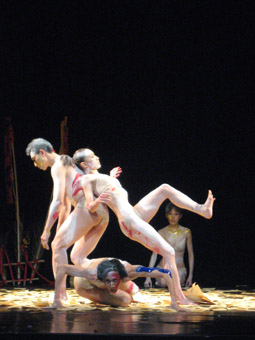
Middle
photo Phalla San
Middle
A MANDALA OF YELLOW SPIRIT MONEY COVERS THE CENTRE OF THE STAGE LIKE A YELLOW BRICK ROAD TO OTHER WORLDS. THREE ALMOST NAKED FIGURES STAND IN ITS MIDST, THEIR ENTWINED BODIES DAUBED WITH THE WHITE OF DEATH AND THE UNKNOWN. CLOSE BEHIND THEM, THE OBSCURED FIGURE OF A SHAMAN IS ENACTING AN ENIGMATIC RITUAL. GONGS AND BELLS CLASH. SUDDENLY, THE SHAMAN’S SHUDDERING HAND THRUSTS OUT BETWEEN THE CLOSE-PACKED BODIES, HIS SPLAYED PALM COLOURED A SHOCKING RED.
This exploration of the journey between this world and the next is Taiwanese choreographer Ho Hsiao-Mei’s short work Middle, performed by Cross Over Dance company on the last day of the 10th Indonesian Dance Festival. In a set rich with colour and texture—the paint on the performers’ smooth bodies, the yellow of the paper spirit money on the floor and the rough browns and reds of the wood and fibre constructions that the dances will shoulder on their spirit journey—Middle creates the dark, mysterious ambience of shamanistic ritual.
Taiwan has a strong tradition of shamans who connect with the spirit world, functioning as healers, diviners, mediums and exorcists. Some use self-mortification techniques, wounding themselves with symbolic implements and mopping up the blood with yellow spirit money (hence the use of red paint in Middle). Taiwanese shamans also employ stylised dance to establish a liminal sphere, a middle ground in which they and spirits may meet. Anthropologist David Jordan describes this as “an athletic ballet, magnificently rehearsed and enthusiastically performed.” Similarly, the shaman figure in Middle is unashamedly virtuosic, treating the audience to high leg kicks with strongly flexed feet, back arches and hand stands. Throughout his performance he stares fixedly into the centre of the audience, his mouth hanging open like the dark hole in a mask.
The other dancers, as pilgrims following the shaman’s lead, display a similarly impressive physicality. During one duet, a male and female dancer press their backs against each other, with one leaning forward and the other leaning back. They transfer their weight seamlessly until the dancer on top has one leg raised weightless in the air, entirely dependent upon the dancer beneath. To the sound of a chiming bell, the dancers slowly reverse their positions, creating a tipping see-saw that demonstrates absolute control.
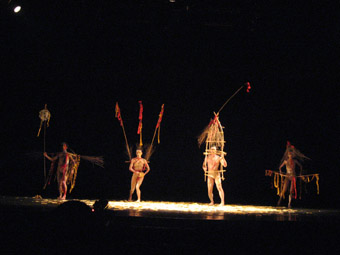
Middle
photo Phalla San
Middle
Middle clearly depicts the different stages of ritual, from separation from reality to the transitional traveling period. When a male dancer holds his partner under the armpits and swings her in a circle, the tips of her toes ruffle the spirit money, destroying the mandala and signaling the beginning of the next phase. The dancers head out of the circle to don extravagant costumes, whose frames suggest phantom hats, huts and warrior flags. Led by the shaman’s skeleton lantern, they pace around the edge of the stage. Every now and again they pause and look around, as if disturbed by the sound of unknown creatures assembling in the darkness.
The repetitive circumnavigation, the gathering gloom and the rhythmic clash of small bells lull the audience into its own trance. But unlike actual shamanistic rituals, Middle does not depict the ceremonial return out of liminality to reality. Having taken us to the threshold of the other world, the work abandons us. The dancers stop circling to stand in a line gazing out at the audience. Then the lights dim, and we are left alone in the darkness with all the phantoms they have conjured leering down at us.
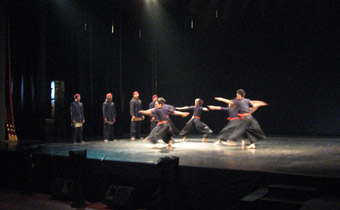
Seruan
photo Phalla San
Seruan
FOUR MEN STAND IN LINE SINGING AS THOUGH IN A TRANCE: “LA ILAHAILLALAH” (THERE IS NO DEITY WORTHY OF WORSHIP EXCEPT ALLAH). THEY WEAR RED CAPS, USUALLY WORN FOR PRAYING, AND BLACK SHIRTS THAT ADD A SPIRITUAL TOUCH TO THE PERFORMANCE. CENTRE STAGE, TWO DANCERS WEARING WIDE TROUSERS CALLED GALEMBONG MOVE TOWARDS THE SINGERS. THE FIRST JOINS THEM AND THE FIVE MOVE SWIFTLY SIDE TO SIDE. THE SINGING AND MOVEMENT GROW FASTER, THE OTHER DANCER JOINS IN AND EVERYONE MOVES IN A CIRCLE.
This moment is a crucial, symbolic part of the dance, blurring the boundaries between singers and dancers and heightening the spiritual mood. The singers and the dancers become one in a trance-like rhythmic state.
In another scene three people lie down in the centre, right and left of the stage. The central one is still as five chanting male singers surround him. He seems trapped, helpless, as though he cannot bear the weight of his “sins”—as the program indicates this work is about “the need for the return of lost conscience.” As the chant grows stronger, the other dancers rise up, but the first man does not move. The chanting perhaps reminds him of the causes for his state and what he must do to get back on the right path. This and the trance-like episode are the most captivating moments in Seruan.
Seruan elaborates the concern of the choreographer, Gusmiati Suid who died in 2001, about the dissolution of tradition and the disappearing influence of religion. Seruan is literally a calling to people to go back to their roots and not lose themselves to modernization. This dance work was revived for the opening program of the 10th Indonesian Dance Festival.
Along with Sardono W Kusumo and several others, Gusmiati Suid is one of the pioneers of contemporary dance in Indonesia. She uses the vocabulary of traditional West Sumatran dances in making her works, often combining them with Randai, a traditional theater form where the sound for a work is usually produced entirely with voice, hand clapping and the movement of the singers. Gusmiati Suid also included in her choreography aspects of Pencak Silat, a traditional martial arts with very dynamic movement, as well as Rantak, a folk dance originating in Minangkabau. This is why martial art footwork, with the legs widely spaced and hands moving swiftly as in combat, is seen from time to time in Seruan.
As well, the dancers often raise their hands, palms open towards the sky, as in Moslem prayer, symbolizing an appeal to God for the granting of wishes.
The dance also included elements of West Sumatran tradition. In the music we often hear the sound of Saluang in the background—a kind of traditional flute played using the pentatonic scale. For those who have been to the area of West Sumatra, the sound would remind them of the great mountainous area, the cool air and the vast paddy fields spread throughout the region.
Seruan ended optimistically. A man and woman take centrestage: both raising their hands as if towards God, answering to the calling of conscience and once again reconnecting with the highest form of being.
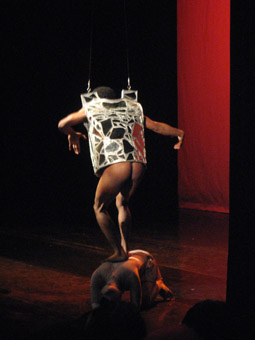
Merah
photo Phalla San
Merah
DIM LIGHTING BARELY DEFINES TWO ISOLATED FIGURES ON STAGE. THEY ARE A STUDY IN CONTRASTS, ONE FEMALE AND TIGHTLY SHEATHED IN WHITE FROM HEAD TO TOE, THE OTHER MALE, NAKED BUT FOR A LOIN CLOTH. STANDING AT OPPOSITE ENDS OF THE STAGE THEY DISTANTLY REGARD EACH OTHER.
This is Merah choreographed and performed by Asri Mery Sidowati, a recent graduate in dance art from the Institut Kesenian Jakarta and one of Indonesia’s emerging choreographers. The unsophisticated work shows a respect for tradition but fortunately does not take the hackneyed route of putting it on a pedestal and placing it in an antagonistic relationship with modernity. Instead we see a valiant attempt to make traditional elements part of her language of expression and not the object. The slow pace of movement and defined silhouettes in Sidowati’s choreography combined with the sound of traditional drums in Arif Susanto’s music provide a tribal, earthy feel, while tradition is also glancingly referenced in her costume. Inspired by Topeng Panji Indramayu (a traditional mask dance) the outfit tightly covers the performer’s body from head to toe, designed as a mask but making her an almost amorphous mass.
From the beginning this ever present masked figure introduces a menacing element of uncertainty. Fading light effectively hides Sidowati from view, revealing only the male dancer, Serraimere Bogie Y Koirewoa, frozen in a proud posture—but the knowledge of her presence remains. Soon the lights subtly illuminate her white silhouette in a flamingo-like stance, arms above her head, one foot raised to knee height. With no other distinguishing features, Sidowati’s image is a mystery that heightens the sense of foreboding.
Slowly a low drum beat reverberates to your core and a sprinkling of sounds evocative of the jungle permeate the senses, while the white backdrop is dappled with irregular shaped patches of light radiating out like the leaves of a tree. The shadows speckle Koirewoa as he wriggles, his dexterous fingers creating a mass of writhing worms that in the mottled light appear to multiply and grow, like nature itself.
The stage brightens revealing muscles so tautly held that Koirewoa appears almost skeletal as he gradually unfolds his limbs. His control and focus amplify each small movement into a luscious image. Jutting his neck out and rolling his shoulders back, he strains forward, nose leading like a beak; his elbows pulled back forming wings he becomes a preening bird. He then morphs into one ready for battle as his arms stretch out, fingers pointing high, preparing to charge. The white figure tentatively tries to copy him, seeming soft in comparison as she raises her arms.
Seeing these two ‘birds’ contrasted, one original and the other a poor imitation, I’m reminded in a flash of Hans Christian Anderson’s The Nightingale. This is a fairytale of an emperor who trades his live nightingale for a mechanical copy, only to find that the machine is far inferior and cannot bring him the same comfort. By presenting a face-off between the natural, embodied in Koreiwoa’s bared body and the artificial, represented by Sidowati’s obscured shape creates a binary opposition, the choreographer underscoring human indifference to rapid climate change and a deteriorating environment.
An angry red seeps into the backdrop as the two figures move towards each other. In slow motion Koirewoa creeps around Sidowati and then clings to her mid-section like a vine. He seems to engulf her, and yet he is powerless as she revolves, carrying him. Having moved the action to her side of the stage, Sidowati, the champion of the ‘artificial’ is winning, as the growing buzz of electronic sound testifies, drowning out the tribal drumming. To crown it all a hard armor-like vest descends, hovering above the pair. Covered with a mosaic of sharp edged shards of mirror, it glints harshly in the light, its patterns a mockery of the dappled ‘tree of light’ that earlier framed Koirewoa.
Completing the take-over, Sidowati offers herself as a platform for Koirewoa to climb up and don the vest. He rises high up, precariously perched on her back, and her control is admirable as she steadily holds the crouched position. Once in the vest, Koirewoa transforms into a mechanical bird; his arms jerk and flail robotically. Then he opens the his vest and we observe a spreading of wings, his twisting torso sending out spikes of light, piercing the stage and blinding the audience—creating a sad distortion of the first ‘tree’…the synthetic has wiped out the organic.
In Merah the choreographer’s intention to show the gradual eradication of the natural world is simply and perhaps too directly stated, the thematic opposition and its development appearing somewhat naive. However, while not intellectually challenging, the evocative sound score, effective lighting and the physical elements of the production, not least Koirewoa’s expert control, can be appreciated.













![S]h]elf](https://www.realtime.org.au/wp-content/uploads/art/36/3671_giang_shelf.jpg)

















![l-r: Giang Dang, Phalla San, Joelle Jacinto [outside theatre]](https://www.realtime.org.au/wp-content/uploads/art/37/3701_gallasch_idf3.jpg)


























